NEW BALD EAGLE
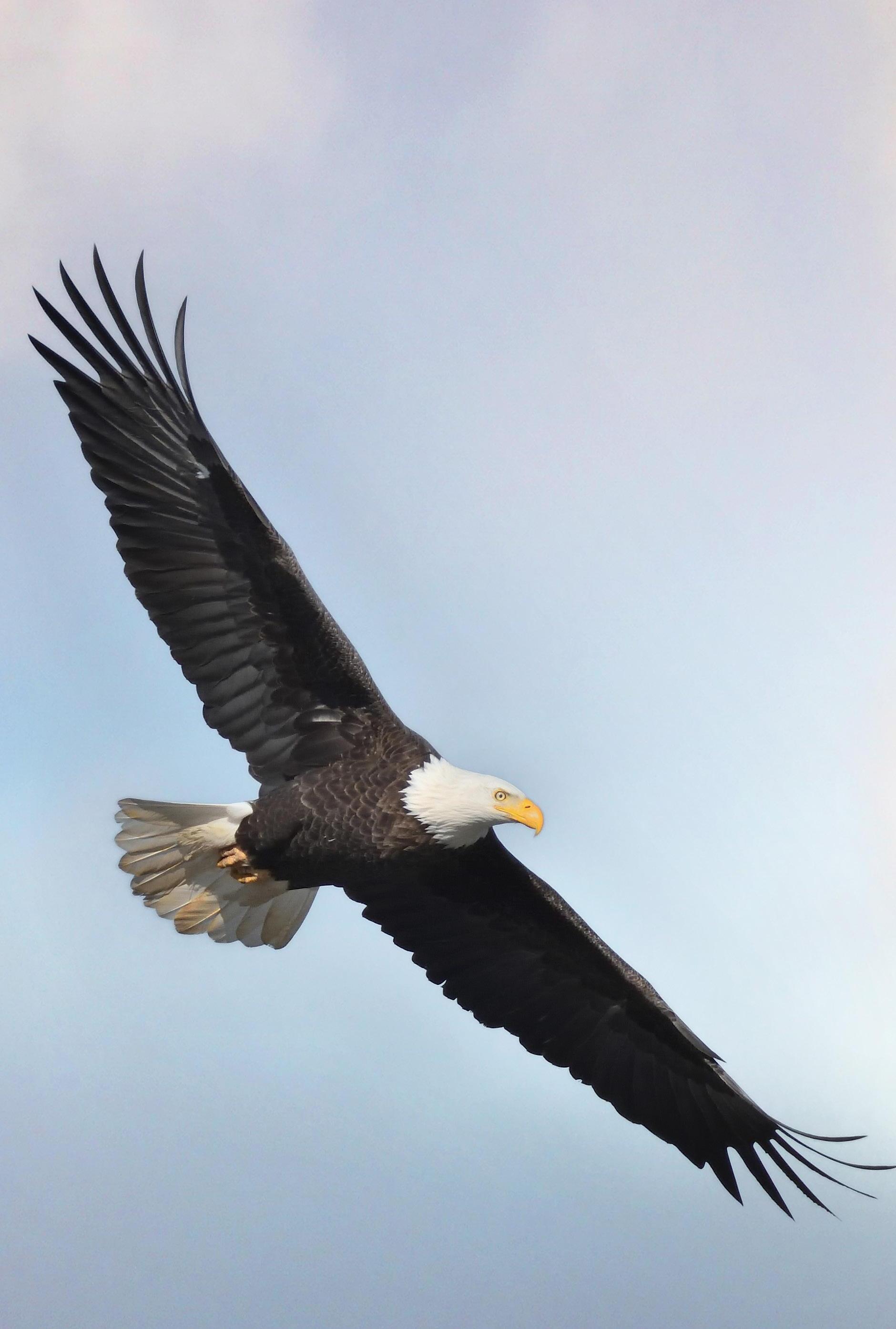
Read the spring migration report on pg. 22
SPRING 2024
RECORD

The mission of Hawk Mountain Sanctuary Association is to conserve birds of prey worldwide by providing leadership in raptor conservation science and education, and by maintaining Hawk Mountain Sanctuary as a model observation, research, and education facility.
MISSION STATEMENT
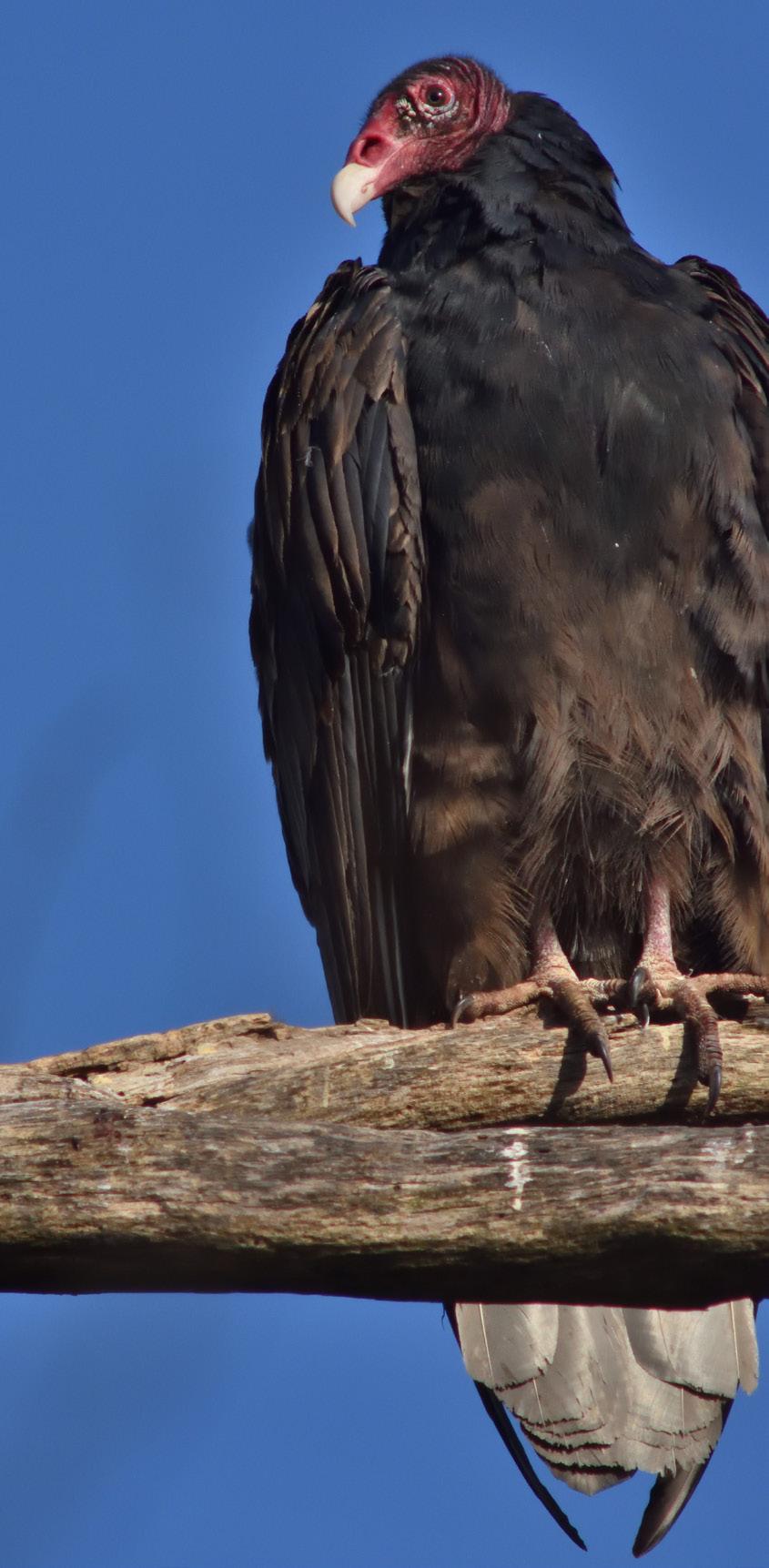
SPRING 2024 • HAWKMOUNTAIN.ORG 1 TOP OF THE MOUNTAIN Celebrating 90 Years NEWS & NOTES RIDGE CURRENTS Summer Camp Success Anniversary Celebrations Visitor Center Updates APPALACHIAN TRAILS Surveying Salamanders FIELD NOTES Assessing Snowy Owls IN FLIGHT Raptor Conservation in Armenia UP & COMING CONSERVATIONIST Chong Leong Puan HAWK MOUNTAIN HAPPENINGS Summer at the Sanctuary Member Exclusive Events MIGRATION REPORT Autumn 2023 SCHOOL IN THE CLOUDS Conservation Field Courses Summer Nature Camp ON THE WING Autumn 2023 Trainees LEAVING A LEGACY Marria Walsh Leadership Giving MOUNTAIN FRIEND Remembering Jim Brett 2 4 6 8 12 14 16 20 22 34 36 38 40
SPRING 2024 NUMBER 140 CONTENTS
COVER PHOTO by Bill Moses
READ THE AUTUMN MIGRATION REPORT Pg 22
Photo by Bill Moses
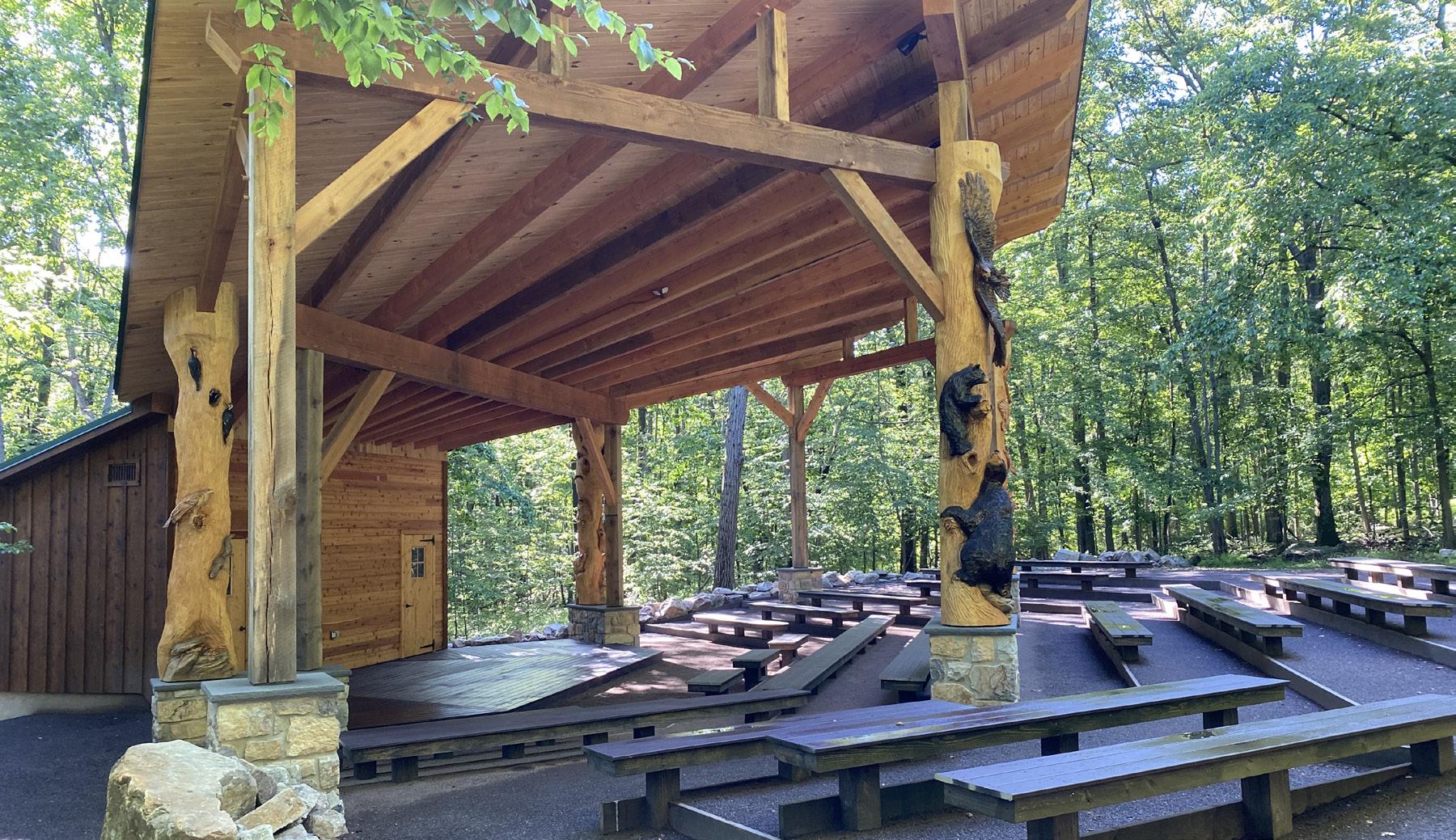
HAWK MOUNTAIN CELEBRATES 90 YEARS
In 1934 we created the first sanctuary for raptors and developed the field of raptor migration science.
In the 1970s we led a movement that inspired hundreds of raptor count sites here in the US and around the globe and shared our established protocols and methods of study that are now utilized by raptor scientists. We were a source for scientific data and inspiration for the founders of the modern-day environmental movement, which led to the Endangered Species Act and to further protections for our national symbol, the bald eagle, and other apex raptors like the peregrine falcon and osprey.
Since then, there has also been an even more dramatic evolution and expansion of our mission, conserving birds of prey worldwide by providing leadership in raptor conservation science and education. We realize that all conservation starts with education and exponentially increased our program offerings to address the community’s needs. This followed an expansion of our
Education Building ten years ago and the opening of a new Amphitheater in 2020 with an ADA accessible trail. We also added a conservation easement in 2019 and adopted a new forest management plan. Today we boast an award-winning stewardship team, modeling best practices in forest management. In four words… We walk the talk!
Today we have recruited and trained more than 500 raptor conservation science and education trainees who participate in a fully endowed, allexpense paid residential program. For many participants, this opportunity would be out of reach, yet it levels the playing field, and trainee graduates hail from 76 countries, with 58% as female and 48% diverse candidates. The science trainee program exponentially grew following the construction and opening of the Acopian Center for Conservation Learning 21 years ago. What has followed are more than 400 scientific papers on raptor conservation science. Our biggest opportunity is to educate visitors about the impact our organization has made in raptor conservation and leverage that work.
2 SPRING 2024 • HAWKMOUNTAIN.ORG
TOP OF THE MOUNTAIN
This year we are providing more opportunities for members to dive deep into our conservation mission, by hosting an onsite Benefit for the Birds and Trainee Reunion weekend from Friday, May 10 to Sunday, May 12. Our “Science Saturday” features a day of talks from our graduates globally, and I invite you to participate in what will be a spectacular year-long celebration of conservation success. You are our most important resource because you believe in our conservation mission.
From our North and South Lookouts, where we provide counters and trainee interpreters each day during our busy four-month-long count season, you will see a diversity of raptors and other migrating birds and if you look and listen you will see an organization, like no other on the planet, with a bright future, and we owe that to you, our dedicated members.

Yours in Conservation,
 Sean Grace PRESIDENT
Sean Grace PRESIDENT

STAFF
PRESIDENT
Sean Grace
DIRECTOR OF CONSERVATION SCIENCE
Laurie Goodrich, Ph.D.
SENIOR SCIENTIST AND GRADUATE STUDY DIRECTOR
Jean-François
Therrien, Ph.D.
SENIOR RESEARCH BIOLOGIST
David Barber
BIOLOGIST-NATURALIST
Bracken Brown
RESEARCH BIOLOGIST
Rebecca McCabe, Ph.D.
ACOPIAN CENTER
OPERATIONS COORDINATOR
Wendy Nicodemus
DIRECTOR OF EDUCATION
Jamie Dawson
EDUCATORS
Jessica Gary
DIRECTOR OF SANCTUARY STEWARDSHIP
Todd Bauman
SANCTUARY STEWARDS
Stephen Wade
Noah Rauch
DIRECTOR OF DEVELOPMENT
Mary Linkevich
MEMBERSHIP & VOLUNTEER MANAGER
Tammy Jandrasitz
COMMUNICATIONS SPECIALIST
Gigi Romano
DEVELOPMENT ASSISTANT
Annie Trexler
PRINTING
BUSINESS MANAGER
Shelley Davenport
BOOKSTORE MANAGER
Mary Therese Grob
BOARD
CHAIRMAN
Tom Kerr
VICE CHAIRMAN
David Bonenberger
TREASURER
Edwin Baldrige
SECRETARY
Wendy McLean, Esq.
Peter Bennett
Jacquelyn Bonomo
Ana Maria Castaño
George Cauffman
Deborah Edge, M.D.
Stephen Edge, M.D.
Peter Fontaine
Jeff Goldenberg
Richard W. Holt
Beth Hucker
Diane Husic, Ph.D.
Ernesto Ruelas
Inzunza, Ph.D.
Nasreen Kara
Jim Lefik
Holly Merker
David Middleton
Sara Nicholas
Sally O’Byrne
Dan Rubenstein, Ph.D.
Jeff Weil
Minturn Wright, III, Emeritus Member
AUTUMN 2021 • HAWKMOUNTAIN.ORG 3
• ALLEGRA LEHIGH VALLEY DESIGN • TAYLOR VAN KOOTEN

CONTINUING TO MAKE HAWK MOUNTAIN ACCESSIBLE TO ALL
As the world’s first sanctuary for birds of prey, Hawk Mountain has been welcoming visitors to our scenic ridgetop to witness the magic of raptor migration for the past 90 years. Our staff and board are committed to promoting diversity, equity, and inclusion in the outdoors. We are continually looking for ways to increase accessibility and provide every visitor with an enjoyable and memorable experience connecting with nature.
We recognized that enhancing our Sanctuary experience for visitors with Autism Spectrum Disorder (ASD) was an area of opportunity. Research suggested that similar facilities offered sensory backpacks and social stories.
Kutztown University’s Dr. Christopher Bloh was contacted to assist with creating these tools. Chris was immediately, and enthusiastically, on board with the project. He visited the Sanctuary twice and provided a detailed ecological assessment of our facilities. He addressed each area and made recommendations for making a visit to Hawk Mountain more comfortable and welcoming for people with sensory sensitivities.
Dr. Bloh went right to work on creating the social stories for our Visitor Center, Outdoor Amphitheater, Native Habitat Garden, and
the Lookout Trail. This required another visit to take more than 50 photographs and write the narrative for each location. This is exactly what we asked for, but Dr. Bloh took the project to a level we were not expecting. He engaged University administration, garnered their full support for the collaboration, and secured a videographer to create short clips to accompany each of the narratives as well. Once the videos are edited, they will be added to our website and YouTube channel for anyone to access.
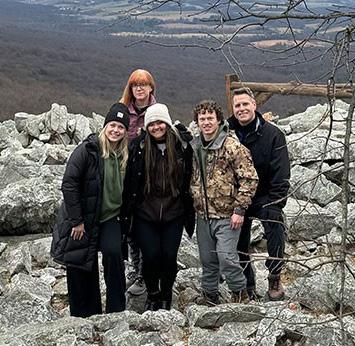
Kutztown special education majors
Page Athey, Joe Tiwold, and recent graduate Hallie Page with Dr. Christopher Bloh and Hawk Mountain Visitor Center Manager Mary-Therese Grob at South Lookout.
We are grateful to Dr. Bloh for sharing his time and expertise to our accessibility initiatives. The final product will provide an informative and useful tool for enhancing our visitor experience and help make the Sanctuary even more accessible for all.
4 SPRING 2024 • HAWKMOUNTAIN.ORG
NEWS & NOTES

AWARD-WINNING SCIENTIST
In September 2023, Dr. Laurie Goodrich, Director of Conservation Science at Hawk Mountain, received a Lifetime Achievement Award at the 2023 Hawk Weekend Festival hosted at the Hawk Ridge Bird Observatory. She was also the keynote speaker, featuring her presentation “From Canada to Colombia: Broad-winged Hawk Migration and Ecology” and presented a seminar for students in the University of Minnesota Duluth biology program.

APPALACHIAN COLLABORATION
For three days in March, the Hawk Mountain Stewardship Team hosted a conference in collaboration with The Nature Conservancy for the Forest Stewardship Council Group. Members ranging from Wisconsin to Georgia attended as part of the Working Woodlands Program. This symposium highlighted two different Pennsylvania sites in our group certificate showcasing several types of timber management, as well as the work our stewardship team is doing at Hawk Mountain to combat invasive species to protect the longevity of our native Appalachian ecosystem.
ONCE-IN-ALIFETIME ECOTOUR
Experience the hawk-watching adventure of a lifetime in Veracruz, Mexico! Witness the spectacular raptor migration at the River of Raptors, explore Mexican bird species and their habitats, immerse yourself in local culture, and visit historical sites. Registration and $500 deposit due by June 15, 2024. Visit hawkmountain.org/ecotours to view the itinerary and other details.
GET INVOLVED WITH THE PA
BIRD ATLAS
Birders across Pennsylvania are teaming up for the 3rd PA Bird Atlas, a five-year survey led by the PA Game Commission and Hawk Mountain Sanctuary. Using Cornell Lab’s eBird tools, volunteers are mapping bird breeding and wintering patterns to inform conservation efforts. Anyone can participate by reporting sightings through eBird, and county compilers are available for assistance, making it accessible to birders of all levels. Learn more at hawkmountain. org/3rdpabirdatlas.
SPRING 2024 • HAWKMOUNTAIN.ORG 5
Summer Camp Success
By Sean Grace, HMS President
Summer Camp has rapidly evolved into our most compact education program in terms of hours of contact, mission served, and fun…it’s no accident. We established engaging, themed weeks of programming across two age groups, and each requires a written curricula planning daily activities with built-in contingencies for rainy weather. Staff and counselors complete training in safety procedures and protocols, safety and logistics considerations, and student-to-teacher ratios. We take responsibility for your camper and that is our top priority.

While working for previous organizations, I developed several summer camp programs and Education Director Jamie Dawson has extensive experience leading residential education programs in the outdoors. When we sat down to plan this program five years ago. We decided to “Bring It”…and by “it,” I mean best practices to ensure a fun, educational, and safe experience that meets your children’s needs and those of the family.
We’ve selected pick up and drop off times that mirror a school day for working parents, and we provide a consistently awesome experience for children, receive accolades from parents, and all the while provide hands on learning and fun experiences for kids. Camp affords children an opportunity to develop deep connections with nature and wildlife through experiential education. Exposure to nature has been linked to a host of benefits including improved attention, lower stress, better mood, and increased cooperation with peers. I know adults that have developed meaningful connections with nature as children are more likely to become responsible stewards of the natural world and help to create healthy ecosystems for wildlife and people.
Visit hawkmountain.org/summercamps to browse the full schedule of week-long day camps featuring a variety of themed adventures.

6 SPRING 2024 • HAWKMOUNTAIN.ORG
RIDGE CURRENTS
Hawk Mountain Celebrates 90 Years with Benefit, Fundraiser, and Trainee Reunion
This year Hawk Mountain is celebrating its 90th anniversary of being the first refuge for birds of prey and home the longest-running raptor migration count in the world. The Sanctuary hosted a celebration May 10-12, starting with its first “Benefit for the Birds” held under a big tent on site and coinciding with its first-ever trainee reunion and 1934 Challenge fundraiser.
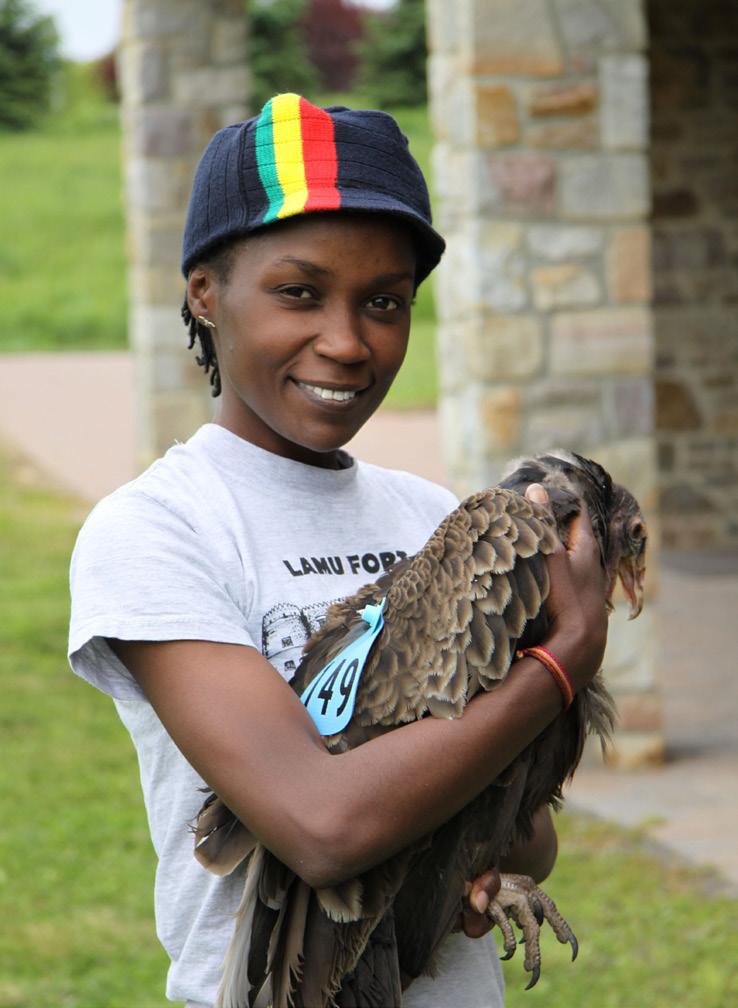
On Friday evening the Sanctuary hosted its annual Benefit with a twist, celebrating with its local and global community on top of the Mountain and enjoying a late spring evening with good food, live music, avian ambassadors, and a raffle of unique prizes all to benefit the Sanctuary. And earlier that day, Hawk Mountain launched it’s inaugural 1934 Challenge, prompting the community to support the Sanctuary with donations of $19, $34, or $90 over the course of 1934 minutes, or just over 32 hours.
On Saturday, May 11, Hawk Mountain hosted a full-day trainee symposium featuring talks and discussions with alumni interns and trainees from around the world as they shared their work in education and science. Visitors got to hear first-hand about the challenges, success, and future of global raptor conservation and mingle with the vast network of conservation collaborators that tie back to the Sanctuary.
Raising the Roof, Improving the Road
As shared before in the Hawk Mountain News, we recognize that our Visitor Center is aging, inefficient, and ineffective. A new facility is a critical need as it serves multiple functions, including as the welcoming point for all visitors to the Mountain. Our plan is to reimagine the Visitor Center to honor the storied legacy of Hawk Mountain while celebrating its far-reaching global impact and vision for the future. And to literally raise the roof, bringing lightness and brightness onto our beautiful soaring raptor carvings.
With a visioning process complete, the staff worked with an exhibit design firm to collect the best ideas from our broad range of stakeholders and drill down concepts for fresh museum exhibits. We also asked: what would a new Visitor Center be without improving our approach and parking area? The stewardship director, president, and others are working to raise funds to improve the gateway and entrance/exit roads, visitor and vehicle flow, and the overall natural experience of a visit to Hawk Mountain.
This is an exciting time in Hawk Mountain history, and our hope is to raise funds fast to put our ambitious plans into immediate action. If you would like to make a difference in raptor conservation today, please contact President Sean Grace at grace@hawkmountain.org.
SPRING 2024 • HAWKMOUNTAIN.ORG 7
Lungless:
Surveying Salamanders with SPARCnet
By Rebekah Smith
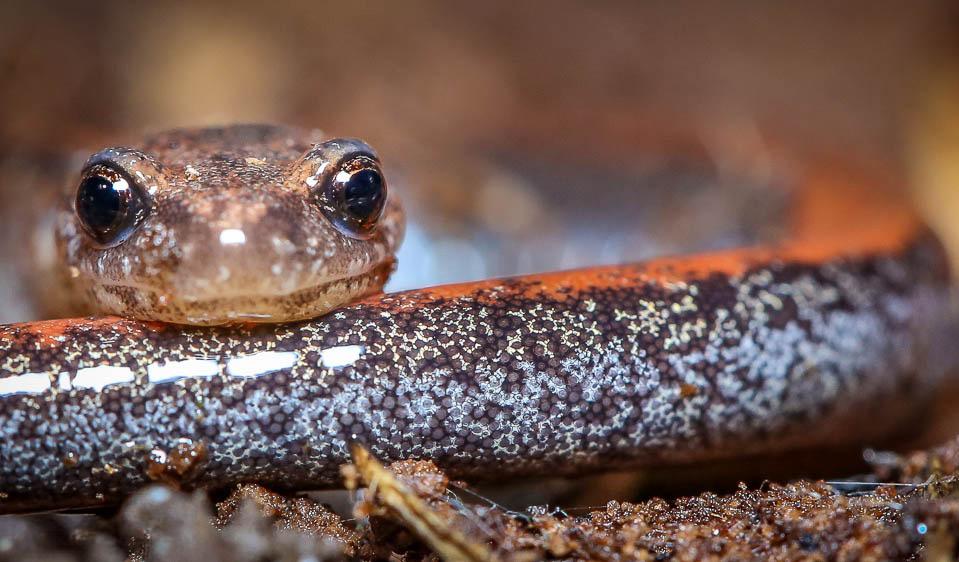
Monitoring raptors that use the Appalachian Mountain range as a landmark for migration and vital habitat will always be the foundation of Hawk Mountain Sanctuary’s legacy. But, just beneath the feet of generations of Hawk Mountain volunteers, students, and staff members, salamanders have been responsible for nutrient cycling the Sanctuary’s mature forested ecosystems, engineering the healthy habitat used by our beloved avian species.
The Appalachian Mountains serve as a global biodiversity hotspot for salamanders, hosting more salamander species than anywhere else in the world. One of the most abundant and widespread species, eastern red-backed salamanders (Plethodon cinereus), spend most of their lives beneath the soil. Yet they are so abundant, their total biomass in forests is likely greater than that of white-tailed deer.
As members of the family Plethidontidae, red-backed salamanders are lungless and absorb oxygen from the environment around them through cutaneous respiration. They thrive in damp habitats because their skin needs to be moist in order to absorb oxygen. Unlike other amphibians in the same region, they are
fully terrestrial, laying their eggs beneath leaf litter and other woodland debris instead of in ephemeral pools. Their offspring hatch as a miniature version of the adults. Although this species is secretive, its ecological value has not gone unnoticed.
Like raptors, salamanders can serve as exceptional bioindicators because they are sensitive to environmental changes. Dr. Tanya Matlaga, Assistant Professor of Biology at Susquehanna University, began studying red-backed salamanders and other amphibians in the Appalachian Mountains in 2013 on private land nestled within the central Pennsylvania mountain range. Around the same time, Tanya joined a team of collaborators at Penn State University and the USGS Northeast Amphibian and Research Monitoring Initiative (NEARMI) to form SPARCnet, the Salamander Population and Adaptation Research Collaboration Network.
Since then, SPARCnet has grown to become an international collaboration effort of more than 50 researchers spanning from Canada to Virginia, and west to Indiana. SPARCnet aims to understand climate adaptation and population dynamics of red-backed salamanders
8 SPRING 2024 • HAWKMOUNTAIN.ORG APPALACHIAN TRAILS
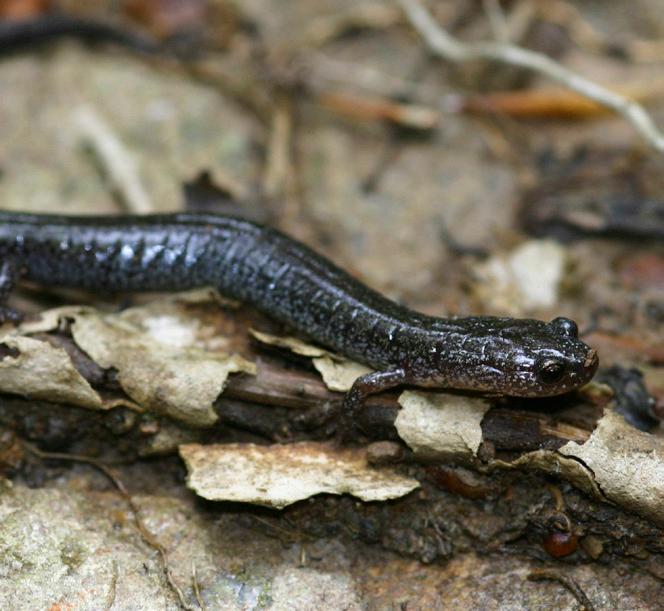

through long-term, capture mark-recapture plot studies. As data is gathered, scientists will be able to ask additional research questions and develop citizen science opportunities, science curricula, and other education materials.

Red-Backed Salamander
Red-backed salamanders are very abundant but underappreciated because they live underground and we don’t see them very often. Because of that alone, we don’t fully understand the many roles they’re playing within the ecosystem and their overall significance to healthy ecosystem functioning.
For more than a decade, Tanya and her students have been monitoring redbacked salamanders during the spring and fall field seasons. In mature forested habitat along the Appalachian Mountains, they survey plots of wooden cover boards for the species, collecting data about their life histories. Each individual captured is checked for fluorescent subcutaneous elastomer markings arranged in a unique ID pattern. They also record information about their body condition and reproductive stage.
The long-term research that Tanya and SPARCnet collaborators participate in builds upon a large body of scientific research on eastern red-backed salamanders. Hawk Mountain Sanctuary founder Rosalie Edge recognized the value of protecting common species, just as SPARCnet researchers aim to study a common species that can serve as a model to inform the scientific community and policymakers. Since eastern red-backed
SPRING 2024 • HAWKMOUNTAIN.ORG 9
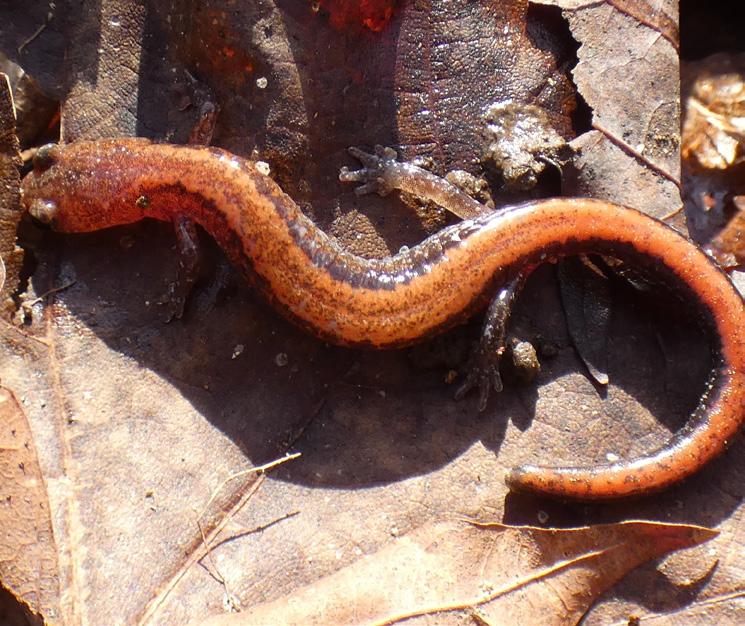
salamanders are abundant across their expansive range from Maine down to North Carolina and west to Minnesota, Tanya and her colleagues can use data gathered about the species to predict how rare amphibians in the same habitats might respond to environmental changes. As climates warm, decreased snowfall and snow accumulation are predicted, which could impact the survival of red-backed salamanders and other related species. Snow provides insulation to the soil where eastern red-backed salamanders find shelter from the winter and heat of summer.
“If we get less snowfall we’re going to have less moisture” Tanya warned. “We’re working on asking questions about whether this species can survive and maintain their populations under the pressure these dryer conditions might bring.”
Tanya and her students study species in artificial mesocosms at the Susquehanna University Freshwater Research Institute, experimental systems where environmental variables can be manipulated to test how species respond. One question they are trying to answer is whether spotted salamander (Ambystoma maculatum) and wood frog (Lithobates sylvaticus) development will be impacted by the loss of eastern hemlock foliage in ephemeral pools due to the invasive hemlock woolly adelgid threat.
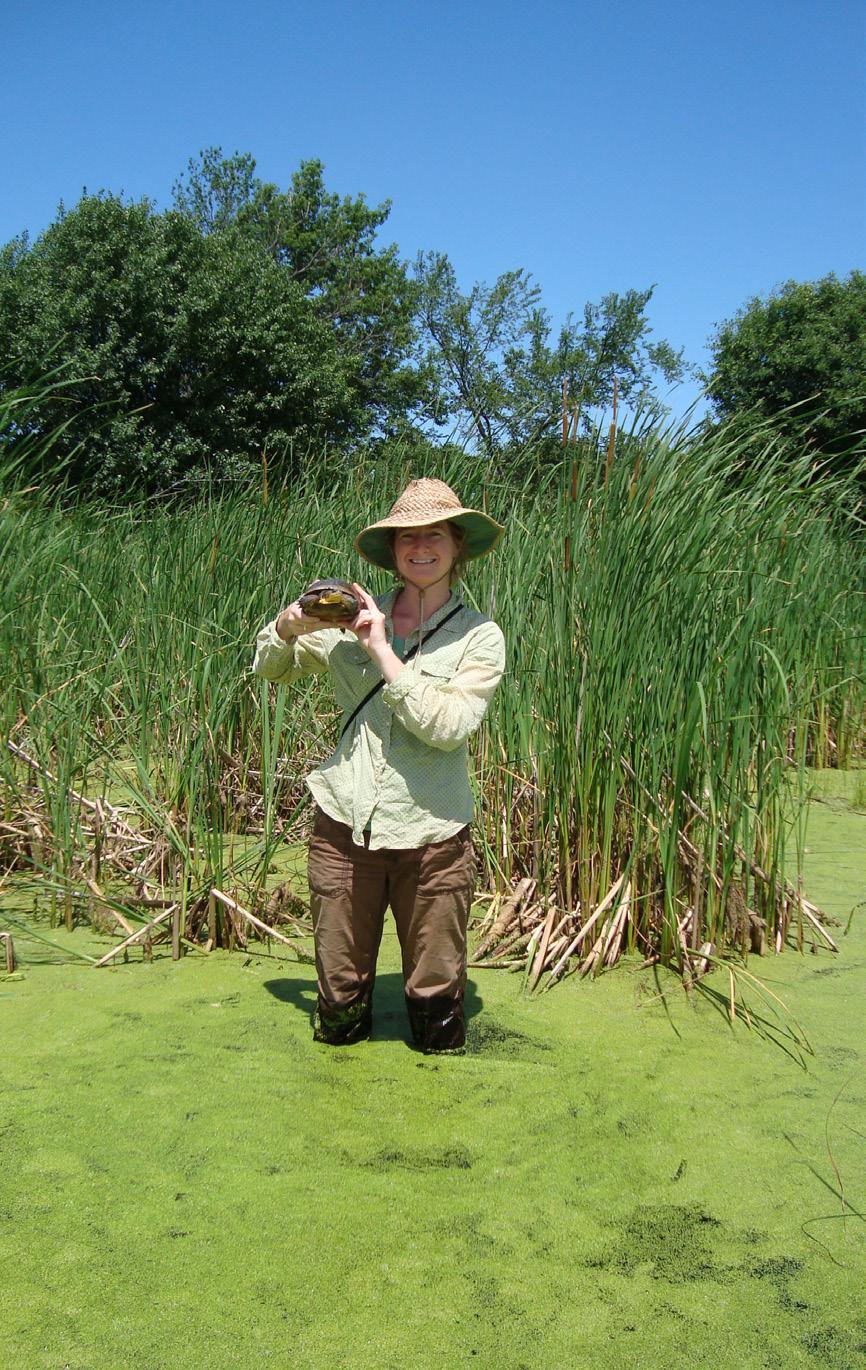
“It’s early, but the wood frogs and Jefferson’s salamanders are already visiting their ephemeral pools,” Tanya noted, returning from a trip to the long-term field site the first week of an already unseasonably warm March. Tanya and her students will be collecting egg masses to use for the mesocosm study. They have also been working to create mesocosms for redbacked salamanders to determine their ability to retain moisture in response to predicted climate variation. With so many questions to answer, Tanya has been looking to the year ahead with an exciting new development for her lab and the SPARCnet collaborative.
In conjunction with SPARCnet, Tanya worked to garner a $3 million National Science Foundation (NSF) grant in 2023 as part of the Research and Mentoring for Postbaccalaureates in Biological Sciences (RaMP) initiative. This incredible accomplishment has allowed SPARCnet
10 SPRING 2024 • HAWKMOUNTAIN.ORG APPALACHIAN TRAILS
to launch a mentorship post-bac program that will span three years, across several universities and at least ten mentors and 30 mentees. Applications for this year’s cohort of mentees will close in late April but will open again next spring for students from underrepresented groups that are within four years of graduating with their bachelor’s degree. The program is designed to help recent graduates by providing additional training and professional development skills before attending graduate school or pursuing research careers.
“We’re always looking for new collaborators as well,” Tanya shared. Additional long-term study sites with the same methodology can serve to bolster their database, providing additional information for collaborators to use to answer valuable research questions.
In just over a decade, SPARCnet, along with Dr. Tanya Matlaga and her colleagues, has created an impressive and sustainable legacy for amphibian conservation. SPARCnet is an exemplary model for the type of long-term scientific collaboration that is much needed in contemporary wildlife conservation. A welcome spark of hope as we face the ever-growing challenges of global biodiversity loss in the Anthropocene.
You can find more information about this research collaborative at SPARCnet.org, or reach out to Dr. Tanya Matlaga at matlagat@susqu.edu.
 Illustration by Rebekah Smith
Illustration by Rebekah Smith

HAWK MOUNTAIN LEADS A CIRCUMPOLAR RESEARCH ENDEAVOR
By Dr. Jean-Francois Therrien, HMS Senior Scientist & Graduate Study Director
A recent study combining the longterm monitoring and global research efforts is shedding light on population abundance and trends for one of the most iconic raptors: the snowy owl. This effort led by Hawk Mountain, entitled “Status assessment and conservation priorities for a circumpolar raptor: the snowy owl,” gathers literally every bit of information available on the species worldwide in an unprecedented way. Under the direction of Hawk Mountain’s Research Biologist Dr. Rebecca McCabe and Senior Scientist and Graduate Study Director Dr. JF Therrien, this endeavor coalesces the work of 39 coauthors spanning nine countries and sets a new standard for population assessments on virtually all raptor species in the future.
Together, the team combined their observations and knowledge on the species. They gathered all the published literature and scientific studies ever done on the species, as well as standardized, long-term data collected around the world for over five decades to assess precise population abundance and trends.
The global population and status of snowy owls are particularly challenging to assess because individuals are irruptive and
nomadic, meaning that they travel longdistances annually to settle and breed where their main prey, lemmings, are numerous. Adding to the complexity, the breeding range is restricted to the remote circumpolar Arctic tundra, and conventional breeding survey methods such as Breeding Bird Surveys, migration counts, eBird, or even Christmas Bird Counts, quickly become

12 SPRING 2024 • HAWKMOUNTAIN.ORG FIELD NOTES




limiting factors when trying to assess vital rates (survival and reproduction rates) precisely. These challenges are even more pronounced when assessing population abundance and trends.
Recently, many national authorities around the world as well as the International Union for Conservation of Nature (IUCN) showed increased concern regarding the snowy owl because many indexes suggest declining trends in population. The authors of the recent study, many of them members of the International Snowy Owl Working Group (ISOWG), conducted the broad review and status assessment to estimate population trends and the current global status of the snowy owl precisely and accurately. We used long-term breeding data, genetic studies,
satellite-GPS tracking, and survival estimates to analyze current population trends at several monitoring sites in the Arctic, and we also reviewed the ecology and threats throughout the snowy owl range. Our assessment of population trends at five longterm monitoring sites suggests that snowy owl populations have indeed decreased during the past three generations.
Additionally, and most importantly, the study identified research avenues and priorities that will improve our understanding of snowy owl biology and make recommendations to orient conservation efforts. Once published, this study will become the benchmark for which many studies and future work will refer to, confirming Hawk Mountain’s leadership role in global raptor conservation.
SPRING 2024 • HAWKMOUNTAIN.ORG 13
Becca with a tracked owl.
Snowy Owl chick
Starting and Growing Conservation Collaborations For Over 20 Years
By Karen Aghababyan, 2004 Conservation Science Trainee & 2023 Ben Olewine Project Soar Recipient

On the night of August 15th, 2003, I stepped into the land of Hawk Mountain Sanctuary (HMS) for the first time. At that moment, I was a pretty experienced field researcher with knowledge of raptor biology and skills of working in various conditions, from deserts to high mountains, rock-climbing, and raptor nest search. Despite my experience, what I saw and learned in the Acopian Center for Conservation Learning of HMS changed my life significantly. It gave me a very strong impulse to shift my interests towards conservation research.
The very next day after landing, I started helping a Ph.D. student in his project of radio-tracking turkey vultures and became actively involved in several other activities of HMS. I should say that I grew up on another side of the Iron Curtain put between the Western world and the Soviet Union, and now I appeared in the sea of information, and like a sponge I was absorbing all the new knowledge.
After my return to Armenia, I continued collaboration with HMS on studying four species of Old-world Vultures, which later became the National Bird Monitoring Scheme. At that time, I started working at the American University of Armenia, and, using the obtained knowledge and skills, I launched several interesting courses for the
students of non-environmental programs. Thus, I was teaching environmental science to the students of business, engineering, policy, and public health programs, demonstrating to them how their professions and nature are interrelated, and how they can help in the improvement of the environment. Collaboration with Hawk Mountain continued through several projects for peregrine falcons and Levant sparrowhawks.

Quite soon, I became a senior researcher at the Acopian Center for the Environment of the American University of Armenia and later became a director of that center. At the same time, using my knowledge and skills obtained in HMS, I helped in founding the Batumi Raptor Count initiative in Georgia, for monitoring raptor migration. After a couple of years, when the center in
14 SPRING 2024 • HAWKMOUNTAIN.ORG IN FLIGHT

the University started growing, I decided to step back from the administrative position and take the position of Chief Scientist. However, at that time, I already started thinking about moving to the NonGovernmental Sector. The thing is I could not influence the policy and all my research findings were staying as good research findings but not more.
That is why in 2015, together with my colleagues we decided to launch a NonGovernmental Organization, which will unite conservation research and policy. In the beginning, we were named TSE – Towards Sustainable Ecosystems – but later we changed to BirdLinks Armenia. Now, the NGO is a leading organization in the country in bird study and conservation. Based on the National Bird Monitoring data, my team and I published over ten articles per year. Also, we wrote the birds’ part of the Red Data Book of Armenia, assessed and designated the areas of conservation importance, and started improving environmental legislation. Also, we became an essential part of the major
regional initiatives, like European Breeding Bird Atlas 2, the development of the Emerald Network, protected under the Bern Convention, leading the African Eurasian Waterbird Agreement, and participation in several other international agreements. In our work related to the study of raptors, we continued collaboration with HMS.
Currently, my main research and conservation interests are within the study of the state of breeding birds in Armenia, modeling of the habitats and populations of the species, development of the action plants for the protection of the species, improvement of responsible hunting, and use of birds as indicators for improvement of sustainability of ecosystem management. I am an expert on the International Union for Conservation of Nature and other conservation and development organizations, and I still have very ambitious plans for the protection of Armenia’s beautiful nature, birds, and raptors. As before, I hope that the collaboration with HMS will continue and will help in raptor conservation.

SPRING 2024 • HAWKMOUNTAIN.ORG 15
Poisoned griffon vulture found during Karen’s research.
Stories and Voices of a Raptor Researcher in Asia
By Chong Leong Puan, Spring 2013 Conservation Science Trainee
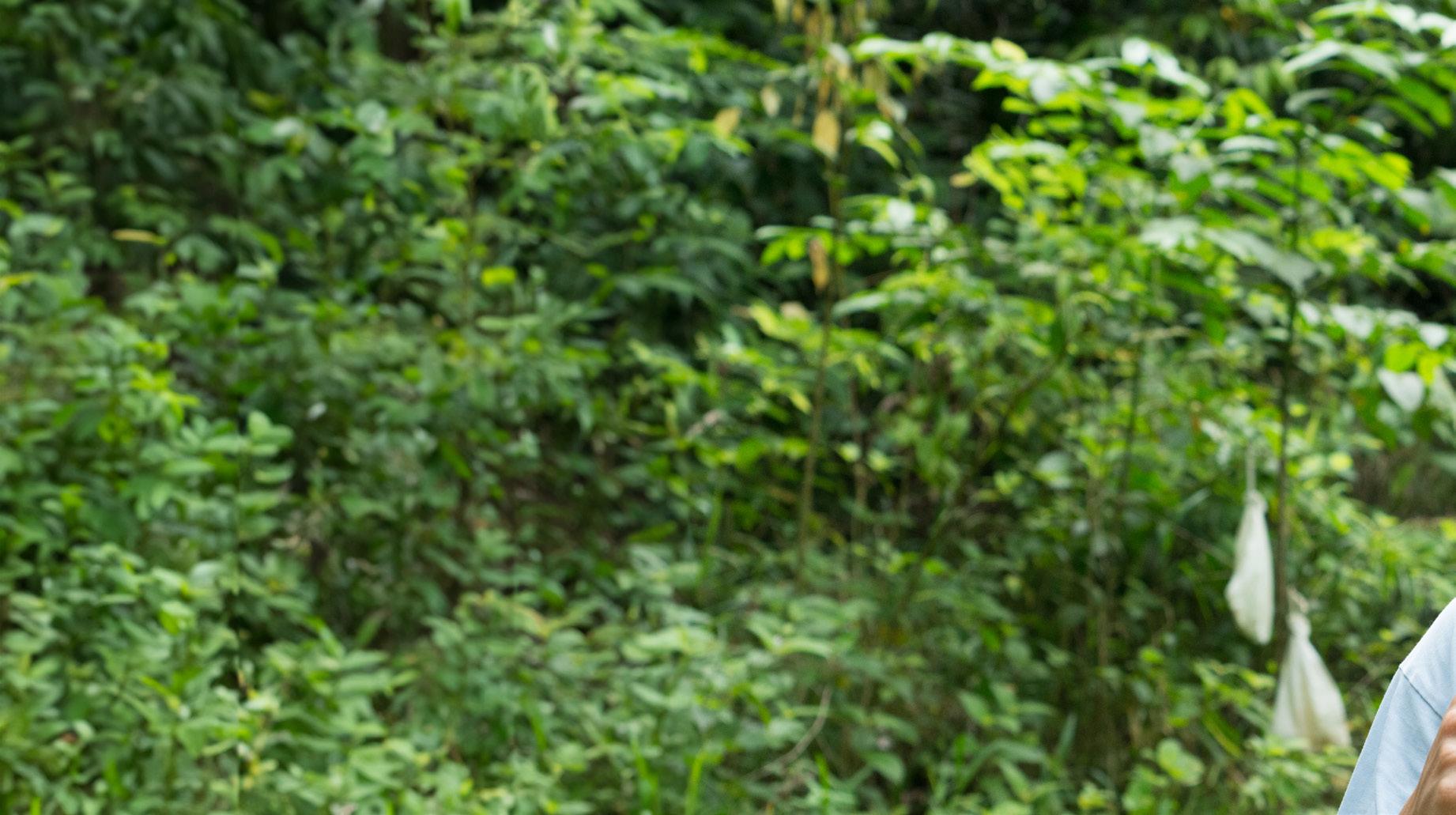
“Conservationist” – a word that was alien to me when I was a kid.
Growing up in the northern part of Kuala Lumpur where the largest Chinese settlement was once located in Peninsular Malaysia, my parents worked in a hawker stall and moved from job to job as business continued to be poor. I was often reminded to get a professional job that can earn more money in the future. During that time, conservation never came across our minds, similar to many average families in many parts of Asia – sustaining the livelihoods of our families was priority. Occupied by work, my parents spent little time at home and rarely asked about my interests.
Back then, we lived in a semi-wooden house surrounded by ex-mining ponds and bushes that got flooded during heavy rains. However, the environment was indeed a perfect natural classroom to explore and a childhood playground to frolic with insects, snails, frogs, skinks, birds, fish, and freshwater turtles. Entering primary school, I think our national educational TV channels did a great job in promoting nature awareness through documentaries. I believe these vivid memories were where my interest and passion started developing.
With the completion of secondary education, I had chosen to do a forestry degree locally where I met and learned from my mentor who was an ornithologist. During one of the mist-net practical sessions in 2005, I caught my first owl, a Sunda scops-owl, that looked very different from those I saw on the TV and in books. One thing led to another, and I worked on barn owls in the plantations for my Ph.D. While the handling of more than a thousand rats during multiple trap sessions to examine the predatory behavior of barn owls was challenging, the skills and experiences in the field were unique and priceless! Then on, I challenged myself to try new things, including presenting a talk on the Malaysian owls for the first time in the Netherlands at the World Owl Conference in 2007. In addition to these experiences, I was delighted to meet some of the greatest raptor researchers around the world and opportunities for collaborations and friendships.
In 2010, I became a lecturer and continued my initial intention to work on nocturnal forest raptors. I continued to seek
16 SPRING 2024 • HAWKMOUNTAIN.ORG UP & COMING CONSERVATIONIST

opportunities to improve my knowledge and skills on raptors including the raptor field techniques in the Linwood Springs Research Station in Wisconsin and raptor monitoring through the Conservation Science Traineeship in Hawk Mountain Sanctuary.
Over the years, many local raptor enthusiasts have provided help and support for my work. It is worth mentioning that my first participation in the Asian Raptor Research and Conservation Network (ARRCN) Symposium in Malaysia in 2005 had led me to know more raptor researchers and their work in this part
Chong Leong Puan

of the world. Since then, I continued to participate in the biennial ARRCN Symposiums and activities and became a member in 2010, and later the Malaysian representative for ARRCN in 2016. In 2022, with the help from many people, I managed to virtually organize the 12th ARRCN Symposium after the first hosted in Malaysia in 2005. ARRCN has certainly provided a platform for raptor research and researchers to grow and expand. It is during these symposiums that I met Dr. Keith Bildstein who introduced me to the Hawk Mountain Sanctuary – a place that was mentioned in a book titled How Birds

SPRING 2024 • HAWKMOUNTAIN.ORG 17
Migrate by Paul Kerlinger that I read when I was a student. As the author described, “… At Hawk Mountain Sanctuary more than half the visitors come in September, October, and November, when hawks are migrating. Jim Brett, curator of Hawk Mountain Sanctuary, and I [the author] are struck by the numbers of people who come from far beyond the borders of Pennsylvania,” this is something I had never imagined I would witness on my own!
Through the years, I consider myself lucky to have had postgraduate students who are passionate and dedicated for the job. Working with them also motivated me to keep going. That was also how my work on Malaysian raptors slowly built up in the past one decade or so. As a result, we gathered more knowledge on habitat requirements, behavior, vocalizations, and

response to environmental changes of local raptor species. Have we done enough? The answer is NO; there is still so much to do with respect to research and conservation of raptors in Asia, especially when there are many species understudied and under threat from multiple factors. Such work requires larger resources that are getting harder to obtain these days.

Until now, I am still holding on to what my Ph.D. supervisor told me, that it is a steep learning curve if I want to become an academician. I remind myself to personally observe to see what works and what does not if I want to continue to do what I do. I am grateful to many individuals, especially friends, mentors, as well as those who have made my journey as a raptor researcher possible. The journey certainly is not as smooth as it seems to be; I learned a lot through the process, not just on research, but also on handling obstacles, criticisms, people, and situations. Persistence is the key to this sort of work.
Am I a conservationist now? In a way, I am, through what I do in research, education, and my extended work. Still, I wish we can have more raptor researchers, especially the younger ones, because there is still so much to know about the Asian raptors.
I believe that things happen for a reason. If I was not born in an environment surrounded by nature, if I did not catch my first owl, and if I did not meet like-minded people, I probably would not have gotten involved in raptor work. So, go explore what you like, and enjoy the journey!
18 SPRING 2024 • HAWKMOUNTAIN.ORG
UP & COMING CONSERVATIONIST

I am proud as a Hawk Mountain alumnus and thankful for the wonderful experiences, training, and connections built from the traineeship. I encourage more young researchers to join the traineeship to enrich your experience and strengthen your skills if you wish to contribute to raptor conservation and research.
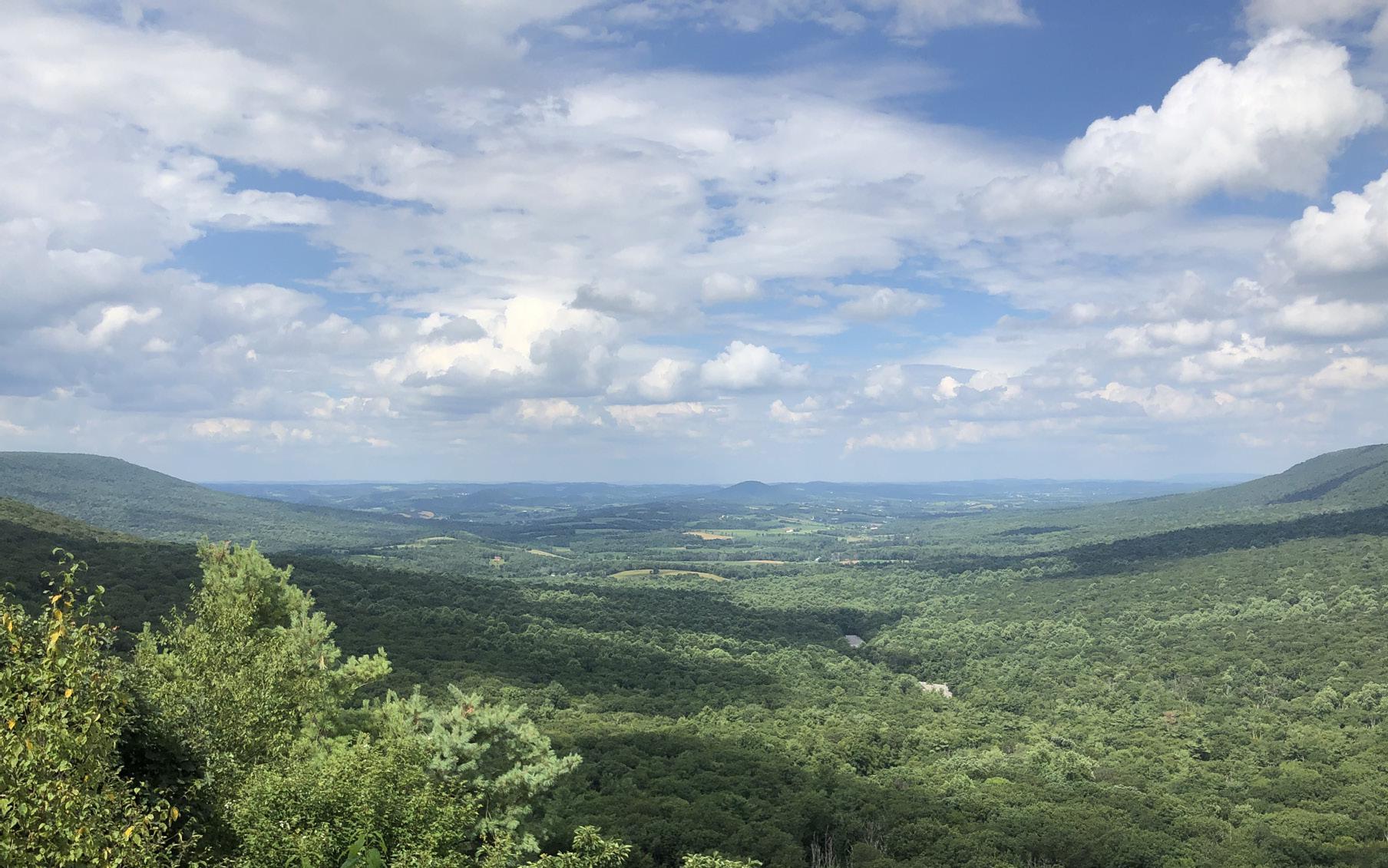
SPRING 2024 • HAWKMOUNTAIN.ORG 19

SUMMER AT THE SANCTUARY
Learn more and register at hawkmountain.org/events
Spring Native Plant Sale
Sat, May 18 • 10 AM – 3 PM
Sun, May 19 • 10 AM – 2 PM
Choose from a wide variety of PA native plants perfect for your home landscape and learn about the importance of native plants from our expert volunteers.
Hawk Mountain Arts Tour
Sat, June 1 • 9 AM - 5 PM • FREE
This self-guided driving tour leads you to a broad mix of artists at home and host studios within a 25-mile radius of the Sanctuary in scenic Albany Township. Visit hawkmountain.org/artstour to see the list of participating artists and the artist map.
Nature Under Your Nose: Nature Photography Workshop
Sat, June 1 • 9 – 11:30 AM
$25, $20 for Members
Join David Greaves for a basic guide into nature photography. This course will touch on camera equipment, camera settings, shot composition, and more.
Butterfly Survey
Sat, June 29 • 10 AM – 2 PM • FREE
Join a naturalist in the garden to participate in Hawk Mountain’s annual North American Butterfly Association fourth of July butterfly survey. Scan and identify butterfly species visiting the native habitat garden and learn about their role in the ecosystem and relationships with host plants.

Breeding Bird Walk
Sat, July 6 • 8 – 10 AM Trail fee for Non-Members
Join HMS staff for a guided birding walk and learn survey techniques used by our biologists to monitor bird populations on the Sanctuary.
Moth Night
Sat, July 20 • 8:30 – 10:30 PM
$15, $10 for Members
Celebrate National Moth Week and discover the wonderful world of these nocturnal winged insects with this informational program and moth watching experience.
Family Forest Fun
Sat, Aug 3 • 10 AM – 2 PM • FREE
Learn about Appalachian flora, fauna, and more at a variety of fun and information stations in and around the Visitor Center. Meet avian and animal ambassadors from Hawk Mountain and Raven Ridge Wildlife.
20 SPRING 2024 • HAWKMOUNTAIN.ORG
HAWK MOUNTAIN HAPPENINGS
Music on the Mountain
Come visit the Mountain and be surrounded by the beauty of nature and live musical performances of local ensembles. Performances take place in the Hawk Mountain Amphitheater and are followed by light refreshments and a live raptor meet-and-greet. Admission is $25, $20 for Mountain Members, and registration is at hawkmountain.ticketleap.com.
Berks Sinfonietta
Saturday, June 8 • 2-4 PM
Gabriel Chamber Ensemble
Sunday, September 8 • 2-3:30 PM

Birds & Brew
Saturday, August 10 • 5 - 8 PM
$65, $35 for those not tasting
Come spend a late summer evening on the Mountain in support of Hawk Mountain and to celebrate the beginning of another autumn migration season! Enjoy unlimited tastings of beers, ciders, seltzers, wines, and more, along with live music and delicious food from The Brickhouse Grill. Admission is $60, $30 for those not participating the tastings.
Tickets sell fast! Get yours at hawkmountain.org/birdsandbrew
Member Exclusive Events
Register now at hawkmountain.ticketleap.com
Hope Hill Lavender Farm Member Mixer
Thu, June 27 • 6 – 8 PM • $45
Take in the incredible view from atop Hope Hill Lavender Farm, meet the owners and learn about their homemade items. Meet a Hawk Mountain feathered educator and enjoy a light dinner prepared by the Brickhouse Grill.
Vulture Encounter
Fri, June 28 • 10 AM – 12 PM • $15
Meet a live black vulture, then learn about vultures’ role in nature and how Hawk Mountain is researching and conserving the species.
Hawkwatching with the President Tue, Oct 15 • 9 AM – 1 PM • $20
Depart on a leisurely hike to North Lookout with President Sean Grace, then scan the skies for migrating raptors. A bagged lunch will be provided to enjoy at North Lookout.

SPRING 2024 • HAWKMOUNTAIN.ORG 21
SETTING RECORDS
By David Barber, Senior Research Biologist
Three inches of fresh snow blanketed North Lookout, a bone-chilling wind howled out of the northwest, and the temperatures hovered in the low teens. Not the conditions that most people would be eager to spend time sitting in while on the exposed lookout, but the perfect conditions for migration in January. Late season counts are all about quality and not quantity, so even though only 19 birds were counted, 14 of them were eagles, including 12 bald eagles, adding to our record-breaking season count. Only 20 years ago the bald bagle count totaled 218; this year’s count of 639 was nearly three times that total—a continuation of America’s greatest conservation success story for arguably our most iconic raptor species.

Red-shouldered Hawk by Bill Moses

AUGUST 2023
AUTUMN MIGRATION REPORT
Day Weather Wind (mph) BLVU TUVU OSPR BAEA NOHA SSHA COHA AGOS UNAC 15 Overcast/Mostly cloudy/Partly cloudy WNW, 1-7 0 0 3 0 0 0 0 0 0 16 Clear/Partly cloudy/Mostly cloudy/Overcast W, 1-7 0 0 0 3 0 0 1 0 0 17 Fog/Partly cloudy SW/SE, 1-8 0 2 5 3 0 0 1 0 0 18 Overcast/Mostly cloudy W, 1-12 0 0 4 8 0 0 2 0 0 19 Clear/Partly cloudy NW, 4-12 0 0 8 7 0 1 0 0 0 20 Haze/Clear W/SW, 0-5 0 0 2 2 0 1 0 0 0 21 Haze/Overcast/Mostly cloudy WNW/NW, 0-10 0 0 2 0 0 1 0 0 0 22 Partly cloudy/Mostly cloudy N/NW, 1-28 0 0 9 8 0 3 2 0 1 23 Overcast SE, 1-3 0 0 4 4 1 0 0 0 0 24 Fog/Drizzle/Rain SSW/S, 5-10 0 0 0 0 0 0 0 0 0 25 Fog/Rain/Overcast SSW/S/SW/ WSW, 1-7 0 0 0 0 0 0 0 0 0 26 Overcast/Mostly cloudy NW, 0-8 0 0 6 2 0 1 0 0 0 27 Clear/Partly cloudy/Mostly cloudy/Overcast VAR, 0-7 0 1 5 3 0 3 0 0 0 28 Partly cloudy/Overcast/Fog ESE/SE/S, 0-18 0 0 4 1 0 4 0 0 0 29 Fog/Overcast/Mostly cloudy S/SW, 1-12 0 1 3 1 0 0 0 0 0 30 Partly cloudy/Mostly cloudy/Overcast NW, 1-12 0 0 11 6 0 2 1 0 0 31 Partly cloudy/Clear NW, 10-20 0 3 5 27 0 4 5 0 0 Total 0 7 71 75 1 20 12 0 1
22
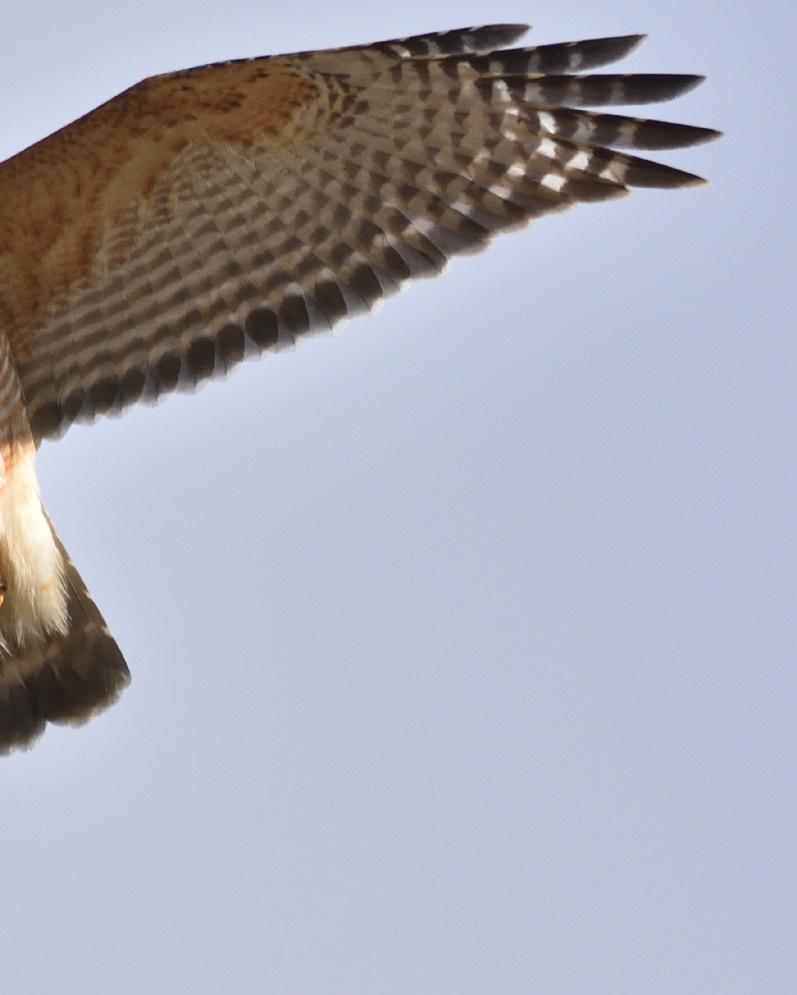
AUGUST • Overcast skies and light westnorthwest winds greeted Research Biologist Becca McCabe on the first day of the official count. Just before 9:30 am, a raptor appeared over number “five” with the classic M-shaped silhouette—an osprey was the first migrant of the season as it glided past the lookout. More raptors were spotted as the day warmed, and a total of 19 birds were counted, including 3 osprey, 10 broad-winged hawks, and 6 red-tailed hawks. Above average flights of broad-winged hawks continued through the end of August, peaking on the 22nd with 65 tallied, and ending the month with a total of 400 broadwings, twice the average for August.
The aerial insectivore flights were impressive through most of August. Volunteer counter Doug Wood swept the swallows on the 20th, tallying six species including season highs of 17 purple martins and 18 northern rough-winged swallows. Barn swallows peaked the next day with 208 counted.
The first large eagle flight occurred on the 31st; 27 bald eagles were counted by Director of Conservation Science Laurie Goodrich and former volunteer counter Paul Heveran. Late morning on the 31st, Goodrich and Heveran spotted a large white bird high over the lookout; it had a long neck and legs, and black flight feathers, a wood stork! The Sanctuary’s first record of this southern species.

0
0
UNAC RSHA BWHA RTHA RLHA UNBU GOEA UNEA AMKE MERL PEFA UNFA UNRA TOTAL 0 0 10 6 0 0 0 0 0 0 0 0 0 19 0 0 7 4 0 0 0 0 1 0 0 0 0 16
0 6 1 0 0 0 0 0 0 0 0 0 18
0
0 9 7 0 0 0 0 7 0 0 0 0 37 0 0 23 9 0 0 0 0 5 4 0 0 0 57 0 0 26 0 0 0 0 0 1 3 0 0 0 35 0 0 17 1 0 0 0 0 3 1 0 0 0 25 1 0 65 10 0 0 0 0 8 1 0 0 0 107 0 0 57 3 0 0 0 0 2 0 0 0 0 71 0 0 1 0 0 0 0 0 0 0 0 0 0 1 0 0 8 1 0 0 0 0 0 1 0 0 0 10
0 22 1 0 1 0 0 2 1 2 0 0 38
0 57 6 0 0 0 0 1 1 0 0 0 77
0 9 3 0 0 0 0 0 1 0 0 0 22 0 1 3 5 0 0 0 0 0 1 0 0 0 15 0 0 23 5 0 1 0 0 3 0 2 0 0 54 0 0 57 17 0 1 0 0 12 2 1 0 0 134 1 1 400 79 0 3 0 0 45 16 5 0 0 736
0
0
23
AUTUMN MIGRATION REPORT
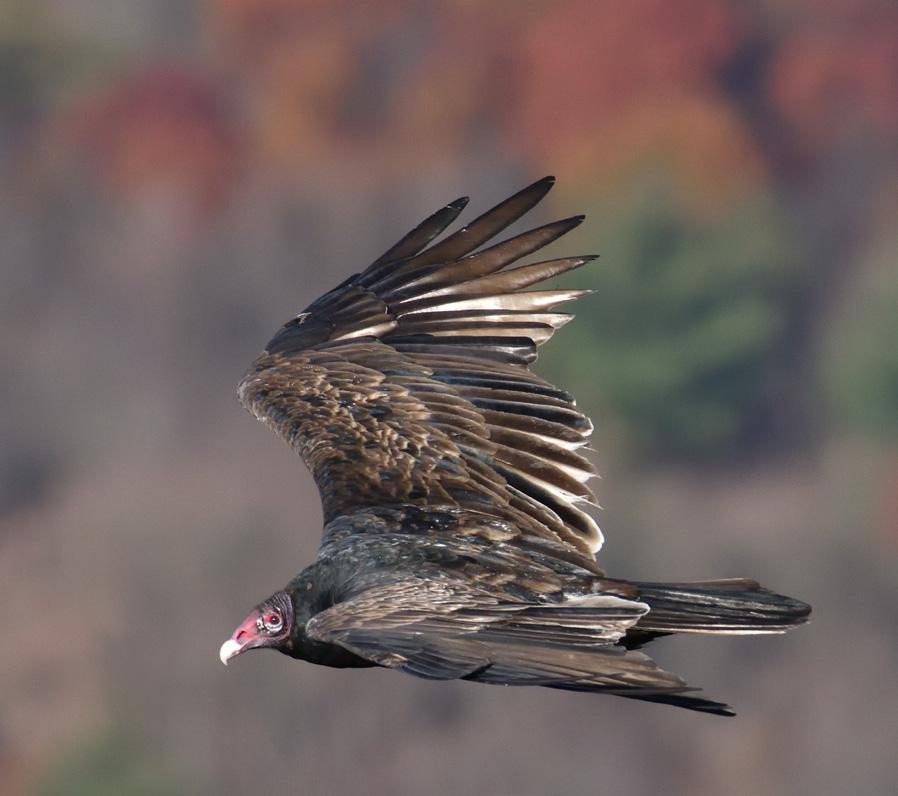
SEPTEMBER 2023
SEPTEMBER • Warbler diversity and numbers peaked in early September with 15 species of warblers observed on both the 4th and the 5th, including season high counts of Tennessee, northern parula, chestnut-sided, magnolia, blackthroated blue, black-throated green, blackburnian, American redstart, and black-and-white warblers on the 4th and high counts of Cape May and baybreasted warblers on the 5th.
Raptor flights were slow through the first third of the month due to lack of cold fronts and light winds. Northwest winds on the 14th produced a season-high count of 11 osprey. Broad-winged hawk flights started to pick-up mid-month with
24 SPRING 2024 • HAWKMOUNTAIN.ORG Day Weather Wind (mph) BLVU TUVU OSPR BAEA NOHA SSHA COHA AGOS UNAC RSHA 1 Clear E, 4-12 0 0 0 1 0 1 1 0 0 2 Partly cloudy/Clear SW/SE/NW, 2-10 0 0 1 2 0 1 0 0 0 3 Clear/Partly cloudy W, 1-3 0 2 4 2 0 4 0 0 0 4 Partly cloudy/Drizzle/Clear NW/WNW/NW, 3-12 0 1 6 4 1 5 4 0 0 5 Partly cloudy/Mostly cloudy/Overcast NW, 1-18 0 1 8 1 0 8 1 0 0 6 Clear/Partly cloudy NW, 1-7 0 0 1 3 1 3 1 0 0 7 Partly cloudy/Overcast/Rain/Thunderstorm VAR/S/SSW, 0-10 0 0 1 1 0 6 0 0 0 8 Fog/Haze/Mostly cloudy/Partly cloudy/ Overcast SSW/W/VAR, 1-7 0 0 1 0 0 10 1 0 0 9 Mostly cloudy/Partly cloudy SSE, 0-12 0 0 6 3 0 20 2 0 0 10 Fog/Rain/Overcast E/SE/S/VAR, 1-3 0 0 2 2 2 11 2 0 0 11 Partly cloudy/Mostly cloudy/Haze/Fog/ Overcast/Thunderstorm NW/VAR, 0-5 0 0 4 1 2 5 1 0 0 12 Clear/Partly cloudy/Mostly cloudy W/NE/NW/N/ SE, 0-7 0 6 8 0 1 18 2 0 0 13 Overcast/Mostly cloudy/Partly cloudy W, 1-12 0 1 4 9 0 11 0 0 0 14 Clear NW, 8-12 0 0 11 6 2 27 6 0 1 15 Clear N/NW, 4-12 0 0 5 10 5 22 3 0 3 16 Clear NW, 8-20 0 1 10 14 1 39 6 0 0 17 Partly cloudy/Overcast/Rain SW/SE, 1-7 0 0 6 1 1 7 0 0 1 18 Drizzle/Fog/Overcast/Mostly cloudy/Partly cloudy NW/WNW, 3-18 0 0 8 10 3 46 1 0 0 19 Clear/Mostly cloudy NW, 3-20 0 0 7 27 2 131 1 0 3 20 Clear/Partly cloudy/Mostly cloudy NW, 1-3 2 1 3 1 0 40 6 0 0 21 Clear/Partly cloudy NW/VAR, 1-8 0 0 6 6 2 36 3 0 0 22 Clear/Partly cloudy/Mostly cloudy/ Overcast E/ESE/VAR, 4-15 0 0 9 2 3 44 4 0 0 23 Rain/Fog NE/ENE/E, 18-25 0 0 0 0 0 0 0 0 0 24 Drizzle/Fog/Rain E, 13-17 0 0 0 0 0 0 0 0 0 25 Rain/Fog NE, 5-20 0 0 0 0 0 1 0 0 0 26 Overcast/Fog/Drizzle/Rain NE, 8-18 0 0 5 0 0 0 0 0 1 27 Mostly cloudy/Partly cloudy NE, 8-15 0 0 1 4 0 4 1 0 0 28 Overcast/Fog SE/E, 1-10 0 0 1 3 2 22 3 0 0 29 Rain/Overcast NE, 1-12 2 0 0 0 0 8 0 0 0 30 Partly cloudy/Overcast/Mostly cloudy NW/WNW/N, 5-15 0 0 2 0 0 16 3 0 1 Total 2 13 120 113 28 546 52 0 10
Turkey Vulture by Bill Moses
the first big flight of 813 on the 15th. Northwest winds dominated the weather over the next five days during the peak of the broadwing flight. Unfortunately, these winds tended to push broadwings to the east, but they did produce a stellar raptor flight on the 19th. Volunteer counter Greg George tallied 7 osprey, 27 bald eagles, 131 sharp-shinned hawks, 188 broad-winged hawks, 8 American kestrels, 4 merlin, and 2 peregrine falcons. As Tropical Storm Ophelia moved up the eastern seaboard, winds shifted to east-southeast, setting up conditions for the big broadwing flight of the season. A nice push in the morning produced 416 broadwings between 10 and 11 am, but the big push occurred late afternoon when extremely high and distant kettles of broadwings
were seen swirling in the clouds; eventually the flight line moved more towards the ridge and late-day hawkwatchers were rewarded with a close flight of broadwings. Close to 1,900 broadwings were spotted between 4 and 6 pm, and a season high 2,537 broadwings was counted for the day. Ophelia dominated the weather for the next four days with northeast winds, intermittent drizzle, and rain, but once the skies cleared, the last push of broadwings moved through on the 27th with 182 tallied.
As the raptor flights slowed at the end of the month, the blue jay migration started heating up. Nearly 1,200 blue jays were recorded flying past the lookout from the 28th to the 30th.
BLVU Black Vulture
TUVU Turkey Vulture
OSPR Osprey
BAEA Bald Eagle
NOHA Northern Harrier
SSHA Sharp-shinned Hawk
COHA Cooper’s Hawk
NOGO Northern Goshawk
UNAC Unidentified Accipiter
RSHA Red-shouldered Hawk
BWHA Broad-winged Hawk
RTHA Red-tailed Hawk
RLHA Rough-legged Hawk
UNBU Unidentified Buteo
GOEA Golden Eagle
AMKE American Kestrel
MERL Merlin
PEFA Peregrine Falcon
UNFA Unidentified Falcon
UNRA Unidentified Raptor
SPRING 2024 • HAWKMOUNTAIN.ORG 25 UNAC RSHA BWHA RTHA RLHA UNBU GOEA UNEA AMKE MERL PEFA UNFA UNRA TOTAL 0 0 4 0 0 0 0 0 1 0 0 0 0 8
1 22 0 0 0 0 0 0 0 0 0 0 27
0 11 3 0 0 0 0 0 2 0 0 0 28
0 50 8 0 0 0 0 2 2 0 0 0 83 0 0 28 5 0 1 0 0 11 3 1 0 0 68 0 0 8 2 0 0 0 0 5 2 0 0 0 26 0 1 45 1 0 0 0 0 4 2 0 0 0 61 0 0 10 0 0 0 0 0 0 3 0 0 0 25 0 0 30 4 0 0 0 0 8 7 0 0 1 81 0 0 7 1 0 0 0 0 0 5 0 0 0 32
0 27 0 0 0 0 0 1 2 0 0 0 43
0 125 0 0 0 0 0 6 1 0 0 0 167
0 184 6 0 0 0 0 5 2 1 0 0 223 1 1 218 7 0 0 0 0 12 2 2 0 0 295 3 0 813 3 0 0 0 0 8 3 1 0 1 877 0 0 481 11 0 2 0 0 12 0 1 0 2 580 1 0 631 0 0 0 0 0 0 0 0 0 0 647 0 0 834 8 0 0 0 0 5 4 2 0 0 921 3 1 188 2 0 0 0 0 8 4 2 0 1 377 0 1 46 0 0 0 0 0 4 0 2 0 0 106 0 0 452 4 0 0 0 0 8 4 0 0 0 521 0 0 2537 3 0 0 0 0 6 4 0 0 2 2614 0 0 0 0 0 0 0 0 0 0 0 0 0 0 0 0 0 0 0 0 0 0 0 0 0 0 0 0 0 0 0 0 0 0 0 0 0 0 0 0 0 1 1 0 20 3 0 0 0 0 0 0 1 0 0 30 0 0 182 1 0 0 0 0 0 0 1 0 0 194 0 0 0 0 0 0 0 0 1 0 0 0 0 32 0 0 0 0 0 0 0 0 0 0 0 0 1 9 1 2 3 2 0 0 0 0 5 1 1 0 1 37 10 7 6956 74 0 3 0 0 112 53 15 0 9 8113
0
0
0
0
0
0
AUTUMN MIGRATION REPORT
OCTOBER • Warmer than normal temperatures during the first week slowed the raptor migration, but blue jays continued their flights, peaking on the 5th with 736 recorded flapping past the lookout. The first dark-eyed juncos of the season, a common winter resident, were spotted on the 2nd. Flocks of vultures started to migrate in early October with a season-high 27 black vultures recorded on the 5th along with 8 turkey vultures. Falcon flights were sporadic with American kestrels and merlins seen most days, but not in large numbers. Volunteer counters Andy Price and Doug Wood counted 15 American kestrels on the 1st, and Jason Deeter and Scott Morrison added 13
OCTOBER 2023
kestrels on the 8th. Seven peregrine falcons were tallied on the 5th, a season high.
Flights of Accipiters were light the first half of the month during what is their peak migration, but the passage of a strong cold front on the 14th created several days of prefect migration conditions; on the 15th, 515 sharp-shinned hawks and 35 Cooper’s hawks were counted along with a season high 31 bald eagles, the first two golden eagles of the season, and a falcon trifecta of 15 American kestrels, 13 merlins and 4 peregrine falcons. The Accipiter flight continued the next day when Biologist-Naturalist Bracken Brown recorded
26 SPRING 2024 • HAWKMOUNTAIN.ORG Day Weather Wind (mph) BLVU TUVU OSPR BAEA NOHA SSHA COHA AGOS UNAC 1 Clear NW, 1-7 0 0 2 4 2 38 8 0 2 Clear/Mostly cloudy/Partly cloudy NW/VAR, 0-15 0 9 5 3 1 54 4 0 3 Clear/Partly cloudy/Mostly cloudy NW/N, 0-7 0 4 0 2 3 36 3 0 4 Clear/Partly cloudy NNW, 1-3 0 0 1 1 1 33 8 0 5 Fog/Partly cloudy S/SE, 5-8 27 8 2 12 0 29 4 0 6 Fog/Rain/Overcast SSE/SE/S, 1-7 3 13 2 1 2 5 1 0 7 Rain/Overcast/Mostly cloudy WNW/NW, 8-20 0 11 2 6 1 7 1 0 8 Partly cloudy/Overcast W/NW, 4-18 3 0 0 12 2 52 2 0 9 Overcast/Clear/Mostly cloudy SW/W, 3-15 0 0 2 6 0 54 1 0 10 Overcast/Mostly cloudy/Partly cloudy VAR, 1-12 0 0 2 1 0 125 5 0 11 Clear W, 1-7 0 7 0 8 0 34 3 0 12 Clear/Partly cloudy/Overcast VAR, 0-5 0 2 0 2 0 34 4 0 13 Clear NW/NNW, 4-12 0 17 3 8 1 48 20 0 14 Rain/Fog 0 0 0 0 0 0 0 0 15 Clear/Partly cloudy/Mostly cloudy/Overcast NW, 8-18 0 38 2 31 3 515 35 0 16 Mostly cloudy/Overcast NW, 5-18 3 22 2 19 5 545 28 0 17 Mostly cloudy/Overcast NW, 0-10 0 45 0 12 5 371 7 0 18 Partly cloudy/Mostly cloudy/Overcast WNW/W, 0-3 0 0 0 1 0 29 2 0 19 Clear/Mostly cloudy/Overcast SE/S, 1-3 0 5 1 3 1 21 6 0 20 Fog/Partly cloudy/Overcast S/SSE, 4-12 10 1 1 3 1 49 14 0 21 Overcast/Mostly cloudy WNW, 15-30 0 17 0 11 3 102 12 0 22 Partly cloudy/Mostly cloudy NNW/NW, 4-12 0 5 1 18 0 191 41 0 23 Partly cloudy/Clear NW, 0-10 0 16 0 9 3 61 13 0 24 Clear/Partly cloudy S/SE/NW/VAR, 1-7 0 2 0 3 8 146 4 2 25 Partly cloudy/Overcast SW, 0-5 0 0 0 0 3 20 2 0 26 Clear/Partly cloudy W/VAR, 0-5 7 70 0 4 2 28 1 0 27 Overcast/Rain/Mostly cloudy/Partly cloudy/ Clear VAR/WSW/SW, 1-7 5 203 0 1 1 46 1 0 28 Clear/Mostly cloudy W, 3-10 20 52 0 11 5 171 15 0 29 Overcast/Rain E, 4-12 0 6 0 0 0 0 0 0 30 Rain/Fog 0 0 0 0 0 0 0 0 31 Clear/Partly cloudy/Mostly cloudy N/NE/NW/E, 0-7 0 0 0 3 1 16 0 0 Total 78 553 28 195 54 2860 245 2
0
a season high 545 sharpies along with 28 Cooper’s hawks and 5 golden eagles. The following day Greg George tallied an additional 371 sharp-shinned hawks for a 3-day total of 1,431 sharpies. Flights of Cooper’s hawks peaked on the 22nd when 41 were observed along with a late osprey, 18 bald eagles, 191 sharp-shinned hawks, 26 red-tailed hawks, 14 kestrels, 5 merlins and a peregrine falcon.
A poor white spruce cone crop in the boreal forest forecasted an irruption of pine siskins this fall, and the first flock of siskins was seen on the 13th. Two days later, an October high of 329 siskins were recorded. A flock of 11 white-winged crossbills were observed on the 23rd.
Two immature American goshawks were spotted on the 24th by Becca McCabe, the first goshawks of the season. Turkey vultures were the most abundant migrant in late October; groups of 2 to 55 turkey vultures were observed migrating south from the 26th through the 28th with a high of 203 vultures recorded on the 27th. Volunteer counter Dave Kruel recorded the last big flight of the season on the 28th with 315 raptors counted including 20 black vultures, 52 turkey vultures, 11 bald eagles, 5 northern harriers, 171 sharp-shinned hawks, 15 Cooper’s hawks, 3 red-shouldered hawks, 19 red-tailed hawks, a golden eagle, 2 American kestrels, 12 merlins, and a peregrine falcon.

AGOS UNAC RSHA BWHA RTHA RLHA UNBU GOEA UNEA AMKE MERL PEFA UNFA UNRA TOTAL 0 0 0 1 9 0 0 0 0 15 3 0 0 0 82
0 0 1 1 0 0 0 0 6 1 1 0 0 86
1 0 0 2 0 0 0 0 3 1 0 0 0 55
0 0 2 1 0 0 0 0 0 1 0 0 0 48 0 1 0 0 9 0 0 0 0 5 3 7 1 0 108 0 0 0 0 0 0 0 0 0 1 0 4 0 0 32 0 0 0 0 1 0 0 0 0 2 1 1 0 0 33 0 0 0 1 2 0 0 0 0 13 2 4 1 0 94 0 0 1 0 1 0 0 0 0 2 1 1 0 0 69 0 0 0 1 2 0 0 0 0 0 0 1 0 0 137
0 2 0 2 0 0 0 0 3 1 0 0 1 61
0
0
0
0
0 0 0 4 0 0 0 0 1 1 4 0 0 52 0 0 0 0 10 0 0 0 0 0 1 2 0 1 111 0 0 0 0 0 0 0 0 0 0 0 0 0 0 0 0 0 2 1 40 0 0 2 0 15 13 4 0 0 701 0 0 5 0 27 0 0 5 0 5 6 2 0 1 675 0 0 3 0 11 0 0 3 0 0 1 0 0 0 458 0 0 0 0 2 0 0 0 0 0 0 0 0 0 34 0 0 2 0 4 0 0 0 0 1 1 0 0 0 45
0 0 2 6 0 0 0 0 0 0 0 0 0 87
0 0 0 6 0 0 1 0 1 4 0 0 0 157
0 2 0 26 0 0 0 0 14 5 1 1 0 305 0 0 5 0 16 0 0 2 0 2 1 2 0 0 130 2 1 1 0 9 0 2 1 0 0 1 0 0 0 180 0 1 2 0 1 0 0 1 0 0 0 0 0 0 30 0 0 1 0 1 0 0 0 0 0 0 0 0 0 114 0 0 2 0 5 0 0 2 0 0 3 0 0 1 270 0 0 3 0 19 0 0 1 0 2 12 2 1 1 315
0 0 0 0 0 0 0 0 0 0 0 0 0 6 0 0 0 0 0 0 0 0 0 0 0 0 0 0 0 0 0 1 0 4 0 0 0 0 0 1 0 0 0 26 2 4 32 9 221 0 2 18 0 91 64 36 4 5 4501
0
0
0
0
27
NOVEMBER • Large flocks of blackbirds started migrating past the lookout in early November. More than 1,000 common grackles were recorded three different days with a high of 1,859 grackles on the 5th. A flock of 15 rusty blackbirds was observed on the 6th.
Senior Scientist JF Therrien tallied a Novemberhigh 174 raptors on the 1st with monthly-high counts of 22 bald eagles and 59 sharp-shinned hawks, as well as 29 turkey vultures, 43 red-tailed hawks, 5 golden eagles, and 3 American kestrels. Flights of red-shouldered and red-tailed hawks were steady through mid-November, although no large flights were recorded. The best late-
NOVEMBER 2023
season Buteo flight occurred on the 11th; volunteer counters Adam Carter and Dave Kruel recorded season-high counts of 13 red-shouldered hawks and 59 red-tailed hawks along with 9 bald eagles, 5 northern harriers, 6 sharp-shinned hawks, 4 Cooper’s hawks and 4 golden eagles. An adult American goshawk was seen on the 19th, one of only two adults counted this fall.
The winter finch flight was light overall this fall, with the exception of pine siskins, but several species were recorded, just not in big numbers. Red crossbills were seen on six days in November with a high of season high of 14 on the 23rd. Five common redpolls were recorded on the 6th.
28 SPRING 2024 • HAWKMOUNTAIN.ORG Day Weather Wind (mph) BLVU TUVU OSPR BAEA NOHA SSHA COHA AGOS UNAC 1 Partly cloudy/Clear NW, 4-12 0 29 0 22 1 59 3 0 2 Clear W/NW, 1-5 0 44 0 5 0 23 1 0 3 Clear SE/SSE, 1-7 2 17 0 4 1 23 6 0 4 Mostly cloudy/Overcast WSW/W, 0-5 0 0 0 0 3 5 0 0 5 Partly cloudy/Haze/Clear WNW/NW, 1-3 0 11 0 8 0 10 2 0 6 Clear/Mostly cloudy/Partly cloudy SE/S/SW, 0-10 16 64 0 1 1 9 0 0 7 Overcast/Mostly cloudy/Partly cloudy/Clear N/SW/NW, 4-12 0 5 0 18 4 4 2 0 8 Clear/Partly cloudy NNW, 1-7 4 11 0 8 4 7 6 0 9 Overcast/Mostly cloudy/Partly cloudy/Clear VAR/SW/NW, 0-5 11 8 0 3 2 2 0 0 10 Overcast/Partly cloudy/Clear WSW/W/NW, 1-7 0 0 0 4 2 0 1 0 11 Clear/Overcast NW/WNW, 1-8 3 0 0 9 5 6 4 0 12 Partly cloudy/Mostly cloudy/Clear N, 1-7 0 9 0 4 2 5 0 0 13 Clear/Partly cloudy/Overcast SW/VAR, 0-10 0 2 0 3 2 2 0 0 14 Partly cloudy/Mostly cloudy/Clear VAR/NW/N/NW, 1-12 0 0 0 8 1 2 4 1 15 Clear/Overcast S, 1-7 1 1 0 0 1 0 1 0 16 Clear/Haze W, 1-5 2 18 0 3 0 1 0 0 17 Mostly cloudy/Overcast S, 4-12 1 23 0 2 3 0 1 0 18 Overcast/Clear NW, 10-20 0 5 0 6 0 0 3 0 19 Clear NW/WNW, 1-3 0 0 0 5 3 0 1 1 20 Clear/Overcast N/NE, 0-10 0 18 0 1 0 1 0 0 21 Overcast/Rain SE, 13-18 0 0 0 0 2 0 0 0 22 Overcast NW, 1-12 0 0 0 2 0 1 0 0 23 Overcast/Mostly cloudy/Partly cloudy NW, 5-15 1 1 0 18 0 2 0 0 24 Overcast/Mostly cloudy/Partly cloudy/Clear NW, 1-12 0 3 0 16 1 0 3 0 25 Clear/Mostly cloudy VAR/S, 0-5 0 0 0 1 0 0 0 0 26 Overcast/Rain SE, 4-12 0 0 0 0 0 0 0 0 27 Fog/Clear/Mostly cloudy/Overcast W, 0-15 0 0 0 13 2 1 0 0 28 Overcast/Partly cloudy/Mostly cloudy/Snow W/NW, 4-24 0 0 0 6 0 1 0 0 29 Clear/Overcast W, 1-7 0 0 0 1 0 0 0 0 30 Haze/Overcast WSW, 0-5 0 1 0 1 0 0 0 0 Total 41 270 0 172 40 164 38 2
0
0
0
Bald eagles continued to migrate past North Lookout in good numbers through November, while the golden eagle flights remained light. There was much to give thanks for on Thanksgiving Day when Laurie Goodrich tallied 18 bald eagles and 3 golden eagles along with 33 red-tailed hawks and a peregrine falcon. The eagle flight continued the next day when Senior Research Biologist, David Barber recorded 16 bald eagles and a season high 7 golden eagles with the last golden eagle gliding past the lookout after sunset.

SPRING 2024 • HAWKMOUNTAIN.ORG 29 AGOS UNAC RSHA BWHA RTHA RLHA UNBU GOEA UNEA AMKE MERL PEFA UNFA UNRA TOTAL
5 1 0 43 0 0 5 0 3 1 1 1 0 174
2 0 0 36 0 0 5 0 0 0 0 0 0 116
0 5 0 26 0 0 4 0 0 1 0 0 0 89 0 0 0 0 1 0 0 0 0 0 0 0 0 0 9 0 0 8 0 30 0 0 0 0 0 1 1 0 0 71 0 0 8 0 18 0 0 1 0 0 1 0 0 0 119 0 1 5 0 4 0 1 1 0 0 0 0 0 0 45 0 1 8 0 32 0 1 0 0 0 1 0 0 0 83 0 0 1 0 9 0 0 3 0 0 0 0 0 0 39
0 0 0 5 0 0 2 0 0 0 0 0 0 14
0 13 0 59 0 0 4 0 0 0 1 0 0 104 0 0 3 0 27 0 0 4 0 0 1 0 0 0 55 0 0 3 0 15 0 0 1 0 0 0 0 0 0 28 1 0 0 0 46 0 0 1 0 0 0 1 0 0 64 0 0 0 0 7 0 0 1 0 0 0 0 0 0 12 0 0 0 0 7 0 0 0 0 0 1 0 0 0 32 0 0 0 0 3 0 0 1 0 0 0 0 0 0 34 0 0 3 0 36 0 0 6 0 0 1 0 0 0 60 1 0 1 0 20 0 0 0 0 0 1 0 0 0 32 0 0 5 0 12 0 0 3 0 0 0 0 0 0 40
0 0 0 2 0 0 0 0 0 0 0 0 0 4 0 0 0 0 8 0 0 1 0 0 0 0 0 0 12 0 0 1 0 33 0 0 3 0 0 0 1 0 0 60
0 3 0 26 0 0 7 0 0 0 2 0 0 61 0 0 0 0 3 0 0 0 0 0 0 0 0 0 4
0
0
0
0
0
0
0
0 0 0 1 0 0 1 0 0 0 0 0 0 2
0 0 0 19 0 0 5 0 0 0 0 0 0 40
0 0 0 11 0 0 1 0 0 0 0 0 0 19 0 0 0 0 1 0 0 0 0 0 0 0 0 0 2 0 0 0 0 3 0 0 0 0 0 0 0 0 0 5 2 9 68 0 543 0 2 60 0 3 9 7 1 0 1429
DECEMBER • Rain and fog stalled the migration the first three days of the month, but birds started moving once the skies cleared. A large flock of turkey vultures moved through on the 4th with 102 vultures migrating down the ridge along with 5 bald eagles, 12 red-tailed hawks and 3 golden eagles for a total of 122 raptors, a December high. A light morph rough-legged hawk was recorded on the 9th, one of only 10 seen at Pennsylvania watchsites this fall.
Strong west-northwest winds ushered in the best waterfowl flight of the season; 630 snow geese, 3,468 Canada geese, 211 tundra swans, 2 common loons, 39 mallards and 5 black scoters flew south over the ridge. The raptor flight did not disappoint either with 77 raptors counted, including 21 black
vultures, 25 bald eagles, 1 northern harrier, 1 sharpshinned hawk, 1 American goshawk, 21 red-tailed hawks and 7 golden eagles.
The last day of the official count was sunny and windy, great conditions to cap off the last day of the official count. A total of 22 birds were recorded, 4 turkey vultures, 1 northern harrier, 8 red-tailed hawks, and 9 bald eagles, setting a new singleseason count record of 619 bald eagles. Of course, migration doesn’t stop on the 15th, photographer Bill Moses ventured to North Lookout on the 19th and tallied three golden eagles. Bracken Brown added to the bald eagle total on the 30th when he recorded 6 balds along with a northern harrier, 2 red-tailed hawks, and 1 golden eagle.

DECEMBER 2023
Day Weather Wind (mph) BLVU TUVU OSPR BAEA NOHA SSHA COHA AGOS UNAC 1 Overcast/Rain S, 0-10 0 0 0 0 0 0 0 0 2 Fog/Overcast WNW/W, 0-10 0 0 0 0 0 0 0 0 3 Rain/Drizzle/Fog 0 0 0 0 0 0 0 0 4 Overcast WNW/W, 0-15 0 102 0 5 0 0 0 0 5 Overcast N, 0-2 0 0 0 4 0 1 0 0 6 Overcast/Snow/Mostly cloudy NW, 1-12 0 7 0 2 1 0 0 0 7 Snow/Fog/Overcast W/SW, 0-5 0 0 0 0 0 0 0 0 8 Overcast/Partly cloudy/Clear SW/S/SE, 1-7 13 3 0 4 0 0 1 0 9 Fog/Haze S/SE, 0-5 0 0 0 0 1 0 0 0 10 Fog/Rain SE, 1-3 0 0 0 0 0 0 0 0 11 Overcast/Mostly cloudy WNW/W, 10-25 21 0 0 25 1 1 0 1 12 Clear SW, 0-5 0 0 0 4 2 1 0 0 13 Clear NW, 4-16 0 0 0 8 1 2 1 0 14 Clear/Partly cloudy WNW, 1-3 2 5 0 3 0 0 1 0 15 Clear W/WNW, 8-12 0 4 0 9 1 0 0 0 19 Overcast/Mostly cloudy NW, 15-20 0 0 0 0 0 0 0 0 30 Overcast W/WNW, 5-15 0 0 0 6 1 0 0 0 Total 36 121 0 70 8 5 3 1
30
MIGRANTS OF NOTE • AUTUMN 2023
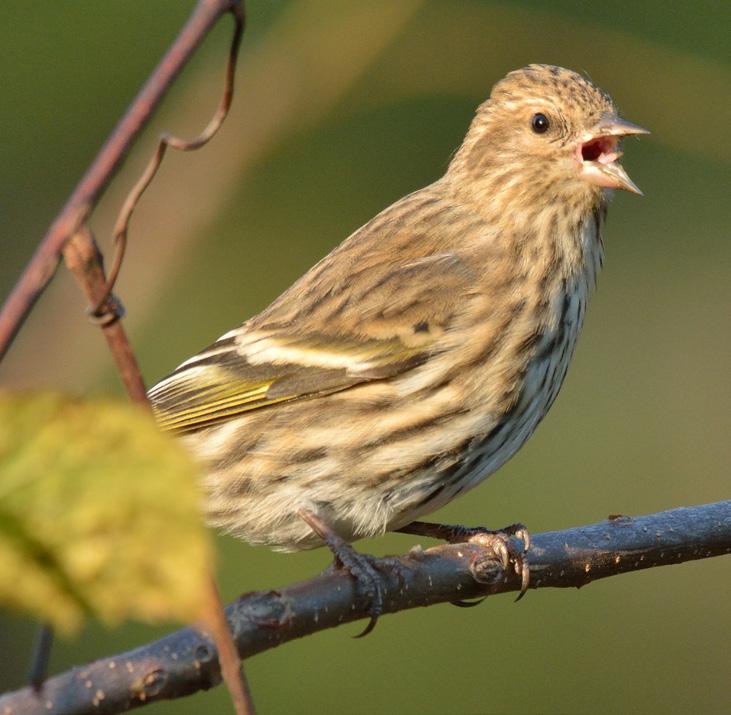


SPRING 2024 • HAWKMOUNTAIN.ORG 31 AGOS UNAC RSHA BWHA RTHA RLHA UNBU GOEA UNEA AMKE MERL PEFA UNFA UNRA TOTAL
0 0 0 0 0 0 0 0 0 0 0 0 0 0
0 0 0 0 0 0 0 0 0 0 0 0 0 0 0 0 0 0 0 0 0 0 0 0 0 0 0 0 0 0 0 0 0 12 0 0 3 0 0 0 0 0 0 122 0 0 0 0 0 0 0 1 0 0 0 0 0 0 6 0 0 0 0 12 0 0 3 0 0 0 1 0 0 26 0 0 0 0 0 0 0 2 0 0 0 0 0 0 2 0 0 1 0 1 0 0 0 0 0 0 0 0 0 23 0 0 0 0 0 1 0 0 0 0 0 0 1 0 3 0 0 0 0 0 0 0 0 0 0 0 0 0 0 0
0 0 0 21 0 0 7 0 0 0 0 0 0 77 0 0 0 0 3 0 0 0 0 0 0 0 0 0 10 0 0 0 0 5 0 0 1 0 0 0 0 0 0 18 0 0 3 0 4 0 0 0 0 0 0 0 0 0 18 0 0 0 0 8 0 0 0 0 0 0 0 0 0 22 0 0 0 0 0 0 0 3 0 0 0 0 0 0 3 0 0 0 0 2 0 0 1 0 0 0 0 0 0 10 1 0 4 0 68 1 0 21 0 0 0 1 1 0 340 Date Peak # Species Total AUGUST 21 208 Barn Swallow 968 27 75 Common Nighthawk 206 SEPTEMBER 4 82 Ruby-throated Hummingbird 380 5 122 Cape May Warbler 360 14 1 Anhinga 1 OCTOBER 2 5 Red-headed Woodpecker 24 16 120 Monarch 1,020 23 5 Sandhill Crane 9 NOVEMBER 5 539 Pine Siskin 2,419 11 8 Snow Bunting 14 20 14 Red Crossbill 40 DECEMBER 5 153 American Goldfinch 1,908 11 28 Common Raven 627 OTHER
0
0
1
Pine Siskin by Bill Moses
Canada Goose by Conrad Kuiper
MIGRATION SUMMARY • It was a mixed season at Hawk Mountain this year. Bald eagles had a big year with a new season-long record of 639 eagles, and turkey vultures had their second highest count with 965. The season-high count of 203 vultures observed on October 23 was the fourth highest single-day count recorded at Hawk Mountain. However, while several species had above average counts, 9 of 16 species had below average counts. The largest drops were seen in American goshawk, 56% below average, red-tailed hawk, 34% below average, osprey and red-shouldered hawk, both 29% below average, and golden eagle, 18% below average. The red-tailed hawk count of 989 was the lowest recorded in Hawk Mountain’s 89-year history, and the redshouldered hawk count of 112 was the second lowest recorded. Hawk Mountain was not the only watchsite in Pennsylvania that experienced below average counts this year. Numbers of osprey, American goshawk, red-tailed hawks, golden eagles, and merlins were below average at all watchsites in Pennsylvania this fall. In fact, if we look at the number of birds passing lookouts per hour (a.k.a. passage rate), which accounts for effort spent watching, Pennsylvania recorded the lowest passage rates for osprey, Cooper’s hawk, American goshawk, red-tailed hawk, and American kestrel in the last 20 years.
The future may not be as dour as it seems for all these species. While Pennsylvania hawkwatchers are seeing fewer Cooper’s and red-tailed hawks,
JANUARY 2024
2023 Autumn Migration Summary
birdwatchers participating in Christmas Bird Counts in many New England states are seeing more, suggesting that Cooper’s and red-tailed hawks are not migrating as far as they have in previous years. Why might that be? Food is the likely reason. Migration is the part of the year most fraught with perils, and where mortality is often the highest. Warmer winters with lower snow cover may have increased access to food for Cooper’s and red-tailed hawks, and if you don’t have to migrate because you have plenty of food, why bother?
For osprey, American goshawk, and American kestrel their declining numbers counted at Hawk Mountain and other watchsites in Pennsylvania are more concerning. Data from Christmas Bird Counts in New England states and Canada show stable and decreasing trends, so it doesn’t appear as though birds aren’t migrating as far as they used to. Moreover, looking at 10- and 20-year migration trends from other parts of the eastern U.S., only one or two watchsites are seeing increasing numbers, which suggests that birds aren’t changing their migration routes. So, what is the cause of these declining counts? It varies by species and could include habitat loss, competition with other species, disease, and environmental contaminants. What is clear, is that more research is needed to determine the causes of these declines.
Many raptors are difficult to monitor due to their secretive nature and large home ranges, and migration counts are the best tool to monitor their
32 SPRING 2024 • HAWKMOUNTAIN.ORG Month Days Hours BLVU TUVU OSPR BAEA NOHA SSHA COHA AGOS UNAC RSHA BWHA RTHA RLHA UNBU GOEA UNEA August 17 178.9 0 7 71 75 1 20 12 0 1 1 400 79 0 3 0 0 September 30 283.9 2 13 120 113 28 546 52 0 10 7 6956 74 0 3 0 0 October 29 277.8 78 553 28 195 54 2860 245 2 4 32 9 221 0 2 18 0 November 30 262.1 41 270 0 172 40 164 38 2 9 68 0 543 0 2 60 0 December 16 101.6 36 121 0 70 8 5 3 1 0 4 0 68 1 0 21 0 January 2 6.5 0 1 0 14 0 0 0 0 0 0 0 4 0 0 2 0 TOTAL 124 1110.8 157 965 219 639 131 3595 350 5 24 112 7365 989 1 10 101 0 10-year Average 122 1102.2 159 715 312 511 122 3606 444 11 59 158 7887 1509 1 31 122 1 15 Aug - 15 Dec Official Count 120 1092.3 157 964 219 619 131 3595 349 5 24 112 7365 983 1 10 95 0
Day Weather Wind (mph) BLVU TUVU OSPR BAEA NOHA SSHA COHA AGOS UNAC 4 Overcast/Partly cloudy NW, 15-20 0 0 0 2 0 0 0 0 20 Overcast/Mostly cloudy/Partly cloudy NW, 13-24 0 1 0 12 0 0 0 0
0
populations. Hawk Mountain, with its long-term count is leading the way providing data that allows scientists to track population trends of these majestic species.
Hawk Mountain scientists are also using our migration counts to track non-raptor populations. This Autumn counters recorded 66,063 non-raptors including 1,297 butterflies and 683 dragonflies. The most abundant non-raptor was Canada goose with 9,775, followed by cedar waxwing (6,811), common grackle (5,314), American robin (4,334), and blue jay (3,432). Early September was the best time for morning songbird flights with impressive numbers
STAFF:
David Barber, Bracken Brown, Laurie Goodrich, Sean Grace, Rebecca McCabe, Jean-Franҫois Therrien.
VOLUNTEERS:
Adam Carter, Jason Deeter, Rob Feldman, Greg George, Dave Kruel, Jon Levin, Holly Merker, Scott Morrison, Andy Price, Beth Sassaman, Jeremy Scheivert, Andy Wlasniewski, Matt Wlasniewski, Doug Wood.
of Cape May and Blackburnian warblers and 23 species of warblers observed. Winter finch numbers were low overall, but a poor white spruce cone crop in the boreal forest forced pine siskins south in big numbers, with this year’s count of 2,419 siskins, the third highest count in the last 24 years. Several notable southerly birds made an appearance this year with the first record of wood stork and the fourth record of anhinga at North Lookout. Some other uncommon non-raptors seen at the lookout this year included sandhill crane, lesser yellowlegs, great and lesser black-backed gulls, house wren, cerulean warbler, and fox sparrow.
0
0

COUNT ASSISTANTS AND DATA VOLUNTEERS:
Chris Arndt, Troy Herrel, John Hilbish, Rudy Keller, Bill Moses, Rich Rieger, 2023 Conservation Science Trainees.
UNEA AMKE MERL PEFA UNFA UNRA TOTAL
45 16 5 0 0 736 0 112 53 15 0 9 8113 0 91 64 36 4 5 4501 0 3 9 7 1 0 1429
0 0 1 1 0 340
0
0 0 0 0 0 21 0 251 142 64 6 14 15140
310 170 66 14 46 16301
1
251 142 64 6 14 15106
33
AGOS UNAC RSHA BWHA RTHA RLHA UNBU GOEA UNEA AMKE MERL PEFA UNFA UNRA TOTAL 0 0 0 0 0 0 0 0 0 0 0 0 0 0 2 0 0 0 0 4 0 0 2 0 0 0 0 0 0 19
Appalachian Ecology Course
Friday, June 14 – Sunday, June 23 | $2800
Hawk Mountain is once again offering a 10-day, immersive course experiencing and learning about the ecology of the Appalachians. Designed for teens ages 15-17 who are interesting in becoming a future conservation professional, this course is based on the principles of service learning and will expose students to a variety of conservation field skills. The course will cover several disciplines, including raptor and songbird field research, forest ecology, habitat management, GIS/GPS, herpetology, entomology, native plant propagation, and more, along with a focus on building valuable life skills. This is a residential course, where all participants will live on site for the full duration. Scholarship opportunities available! Details and information on how to apply can be found at hawkmountain.org/AppEcologyCourse.
Introduction to Raptor Field Techniques
Thursday, June 20 – Sunday, June 23
$675, $625 for Members
This four-day workshop will help you build confidence in your raptor field techniques. Learn new methods or hone existing skills through hands-on learning experiences with raptors, including trapping methods, handling, bird banding, blood sampling, satellite telemetry, and more. Students will participate directly in real research projects with significant individual interaction and training. No special training is necessary, and the class is open to the public. Learn more at hawkmountain.org/RaptorFieldCourse
Appalachian Field Institute Workshops
These 1-to-3-day field-oriented workshops are designed for the amateur or professional naturalist who is interested in learning more about the natural history and ecology of the central Appalachians. These workshops can be taken individually or as a series and can be considered for independent study credit for college students or continuing education for Educators. Certificates of completion will be provided to all attendees, and no experience is required, other than ability and gear for hiking rocky terrain on Hawk Mountain trails. Visit hawkmountain.org/AppFieldInstitute for details and registration.
July 27 – Appalachian Pollinators: Bees, Butterflies, & Plants
Sept 21-22 – Migration Magic: Enjoying Neotropical Migrant Birds on the Move
Jan 17-19, 2024 – Appalachian Winter Ecology
Captive Raptor Management Workshop
Saturday, December 7 – Sunday, December 8 | $325, $300 for Members
Join us to learn about the methods and techniques that we, as global leaders in the raptor world, utilize to manage our captive raptor collection. During this two-day workshop there will be interactive demonstrations of raptor beak and nail trimming, presentation and restraint handling, raptor equipment creation and management, and general raptor husbandry. Also, learn how falconers train raptors and experience the thrill of holding a falconer’s raptor and having it fly from your arm. No experience necessary.
34 SPRING 2024 • HAWKMOUNTAIN.ORG SCHOOL IN THE CLOUDS
CONSERVATION FIELD COURSES

WILD About Raptors Educator Workshop
Tuesday, Aug 20 | $15
This workshop will provide formal and non-formal K-12 educators with lesson plans and activities that focus on adaptations, natural history, and the conservation status of raptors. Meet live raptor ambassadors, build raptor identification skills, and hike to the scenic North Lookout. Act 48 hours available.
SUMMER NATURE CAMPS
$300, $250 for Members, per week 8:30 AM – 3:30 PM, daily
Designed for youth entering grades 1 – 6, these week-long day camps get kids outdoors, developing a deeper connection with the natural world through fun and educational activities. Campers can choose one week or join us for the entire summer!
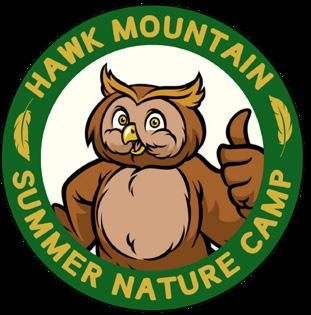
Registration closes and all required forms are due two weeks before start of chosen camp. Scholarship opportunities available! Visit hawkmountain.org/summercamps for more
Creative Creatures
June 17 – 21
Explore nature and creative expression through art, music, and movement.
Uncover the natural world and meet live animals to inspire your imagination!
Animal Kingdom
June 24 – 28
Get up close and personal with mammals, reptiles, birds, insects, and much more. Discover the animal kingdom through crafts, games, special guests, and of course LIVE animals!
Mountain Adventure
July 1 – 3
Hike, explore, and discover Hawk Mountain! Meet up with some birds of prey or chill out with some reptiles while learning about Appalachian wildlife. This action-packed THREE-DAY camp is perfect for first time campers or those coming back for more!
Wild Survivors
July 8 – 12
Learn survival skills through handson experiences while building new friendships. Discover how humans, plants, and animals survive in the wild.
Junior Veterinarian
July 15 – 19
Have you ever dreamed of becoming a vet?
Take a look behind the scenes at what it takes to help injured wildlife and other animals.
Ancient Survivors
July 22 – 26
Learn about civilizations of the past through stories, games, and handson activities! Special guests and live animals help history come alive during our adventures through history.
Science Safari
July 29 – August 2
Come to the camp where we will ask: why and how? Campers will investigate the wonders of the world through experiments and hands-on activities.
Eco Explorers
August 5 – 9
Discover the amazing connections of nature! Observe plants and live animals up close in their natural habitats. No stone will be left unturned as we explore Hawk Mountain!
SPRING 2024 • HAWKMOUNTAIN.ORG 35
Autumn 2023 Conservation Science & Academic Trainees
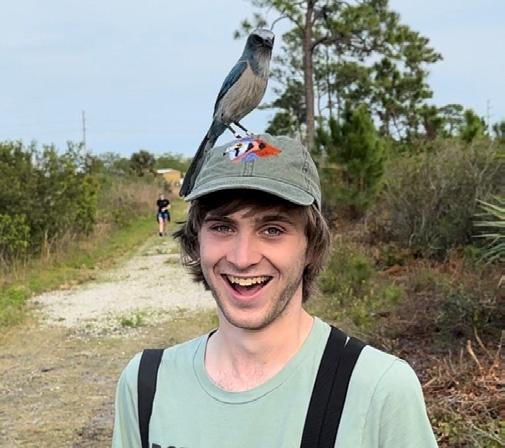
TROY HERREL
GALENA, OHIO
Troy is earned a B.S. in zoology from Ohio State University, and his research experience includes bird banding with Ohio Wesleyan University, bluebird nesting trail maintenance with Big Walnut Preserve where he maintained and monitored over 200 nesting boxes, and data collection on window strikes at the Ohio State University campus. Troy also volunteers with the Youth Education Committee for the Ohio Ornithological Society, and is a tour guide for The Biggest Week in American Birding, the Central Ohio Regional Director for the Ohio Ornithological Society, and the Treasurer for the Ohio State Ornithology Club. Troy hopes to explore field positions and possibly work for the National Park Service while he continues to teach others about birds and the environment.
AIGERIM OLZHAYEVA
ASTANA, KAZAKHSTAN
Aigerim is a Ph.D. student at the Saken Seifullin Kazakh Agro Technical Research University and working with former leadership trainee Dr. Todd Katzner. She earned her M.S. in forestry and B.S. in ecology. Aigerim’s two main research projects include studying the effect of environmental factors on forest ecosystems within the steppe zone of Kazakhstan and assessing and determining ways to improve the green spaces in the city of Astana and its suburban areas. After her traineeship Aigerim plans to use what she’s learned at Hawk Mountain and publish her doctoral dissertation. She also intends to work with the management of raptor populations in central Asia and preserving the biodiversity of Kazakhstan.

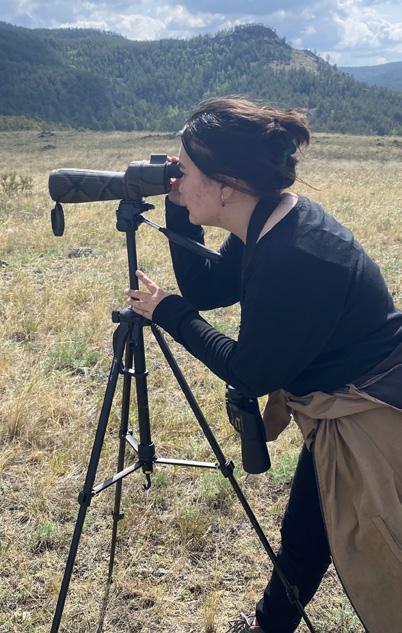
NATIVIDAD AGUILERA ALCALÁ
LA PAMPA, ARGENTINA
Natividad received her Ph.D. in environmental and sustainability science from the National University of La Pampa. Natividad received her master’s degree in biodiversity and conservation biology in 2015 from the Pablo de Olavide University and Doñana Biological Station in Spain, and a bachelor’s in biology from the University of Granada, Spain, in 2014. She has co-authored several publications and has contributed many times with presentations or posters at ornithological conferences. Natividad is currently working with a Hawk Mountain trainee alumnus Diego Gallego Garcia (spring 2022) in Argentina where they are focusing on the breeding biology, survival, mortality, dispersal, and migration of turkey vultures and black vultures in central Argentina using camera traps and wing tags. At Hawk Mountain, she worked with Hawk Mountain scientists to analyze vulture survey data from the Americas while serving as another mentor to her fellow trainees.
36 SPRING 2024 • HAWKMOUNTAIN.ORG ON THE WING
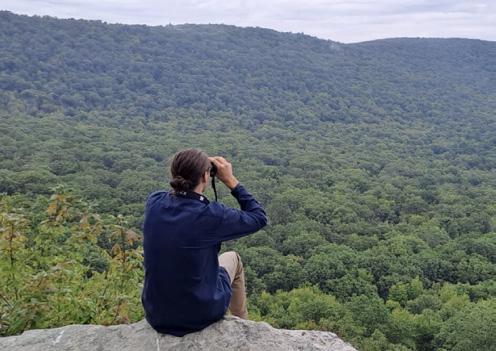
ZACHARY BURKE
MCVEYTON, PENNSYLVANIA
Zachary earned a B.S. in ecology and evolution from the University of Pittsburgh where he has conducted stream sampling along with educating small groups. As a member of the Outdoor and Birding Clubs in Wyoming, he also learned field sampling techniques with plants, insects, birds, and small vertebrates. Zach intends to gain as much field experience as possible during his traineeship and to translate his love of nature into active conservation work. After his traineeship Zachary plans to pursue a master’s degree and conduct research in ecology.
SELENE ANAIS MARTÍNEZ CRUZ
VERACRUZ, MEXICO
Selene is a 2023 graduate of Veracruz University where she completed her B.S. in biology. Selene has volunteered more than 10 years at the Pronatura Veracruz banding station and worked at the Center for Technological Studies of the Sea as an Aquaculture Department Assistant. Selene plans to complete her master’s in avian ecology and continue her work to advance the River of Raptors project in Veracruz.
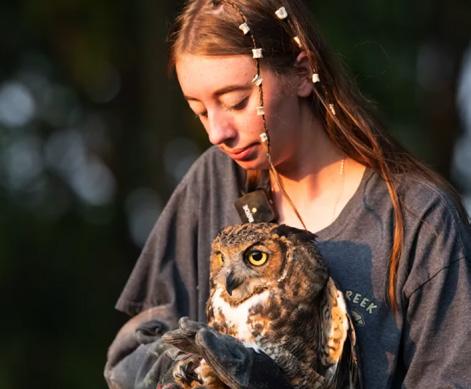

MEGAN JOHNSON
ASHLAND, PENNSYLVANIA
Megan is a 2023 graduate of Kutztown University where she received a bachelor’s degree in organismal biology. She serves as a wildlife rehabilitation assistant at Red Creek Wildlife Center where she helps provide wildlife care and handles raptors for education programs. While at Kutztown, Megan was a Biology Department Museum Assistant where she prepared and catalogued specimens, and was president of the Ornithology Club and a member of the Plant Club. Megan also was a research assistant at Kutztown with Dr. Todd Underwood and helped to conduct research with migrating veeries and captured and banded songbirds.
MOLLY LAURY
BATH, PENNSYLVANIA
Molly is a 2022 graduate of Muhlenberg College where she received a B.S. in environmental science and had a double minor in statistics and sustainability studies. Molly completed two study abroad opportunities with the School for Field Studies in Bocas del Toro, Panama, where she characterized locations around the Archipelago of Bocas del Tora for coral transplant. Her second opportunity was with MILA Costa Rica, where she completed a course on Community Sustainability in Costa Rica and studied the impact of riparian forest cover on water quality in the Abanggres watershed. Molly recently completed a summer internship with the Hawk Mountain Education Department where she assisted with summer day camp, raptor care, and public programs, and served previously as an Animal Care Intern for the Lehigh Valley Zoo.

SPRING 2024 • HAWKMOUNTAIN.ORG 37
Marria Walsh LEAVE A LEGACY
“I believe strongly in the mission of Hawk Mountain and felt it was important to become a member of the Rosalie Edge Society. Together we will help to ensure the future of the Sanctuary.”
Thanks to her childhood fascination with nature, Marria Walsh knew by grade school that one day she would be a biologist. Growing up in Tamaqua, Schuylkill County, the nearby Hawk Mountain Sanctuary was a close destination that she explored throughout her youth with her mother. Later, she would visit the Sanctuary with the Girl Scouts, and then with friends. Her regular visits continue today, and you can often find Marria with a birding buddy, binoculars in hand, checking the bird feeder windows and strolling the Native Habitat Garden.
“It was Hawk Mountain that fueled my thirst for nature and the environment,” she explains, and the world is a better place for it. She went on to pursue her dream, securing a 38-year career as a Marine Biologist with the Environmental Protection Agency in Annapolis, MD. Her roles included positions as Chief Scientist for various survey projects and helping to establish the Delaware Estuary Program, among many other accolades.

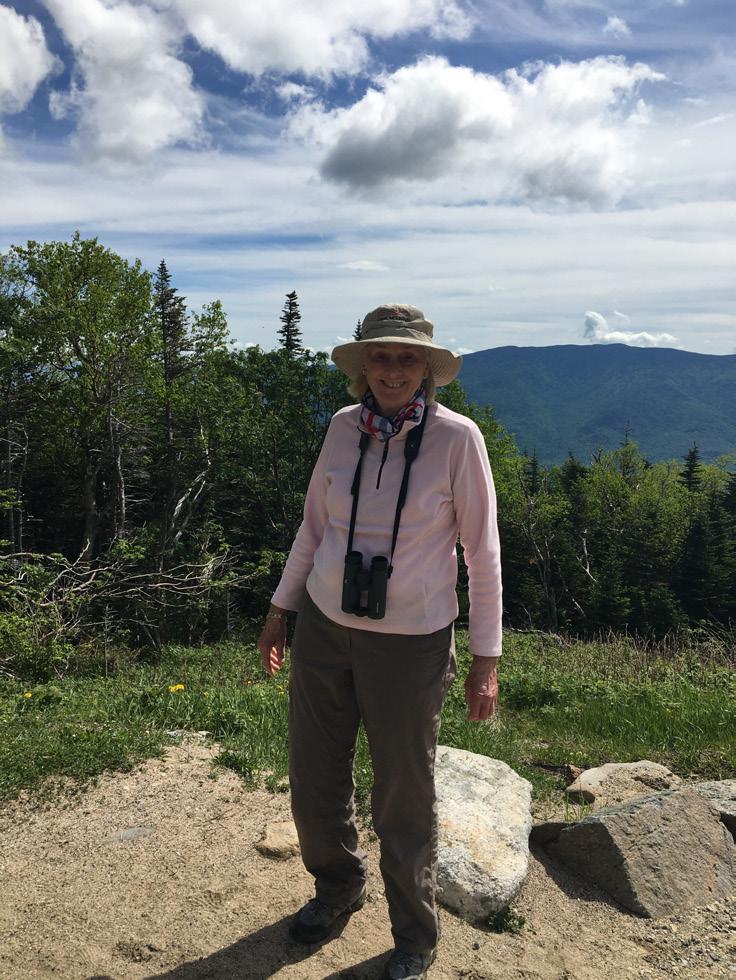
When she retired back to Schuylkill County in 2008, she reconnected with Hawk Mountain as a trailhead gate volunteer, resuming her visits, and attending events and programs.
“I knew from my life-long connections that Hawk Mountain had evolved into a global leader for raptor conservation, while continuing to serve as an educational resource for local schools and youth groups,” she says.
That’s why in 2021 Marria made the caring decision to make a planned gift that will one day help secure the future of the Sanctuary for generations to come, and as such, joining the ranks of the Rosalie Edge Society. If you too feel like Marria, have named the Sanctuary in your will, or would like to learn more, please contact us today.
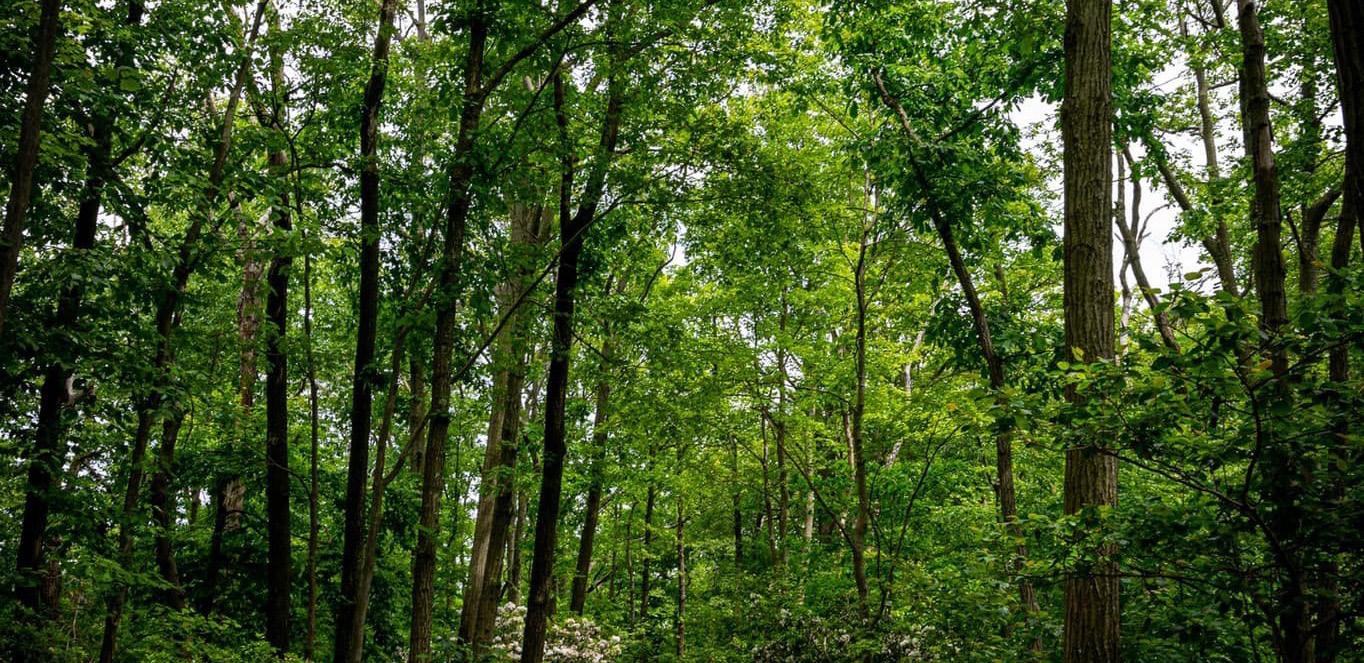
Learn More or Share Your Story Today: Mary Linkevich, Director of Development 610-756-6000 x212 linkevich@hawkmountain.org
38 SPRING 2024 • HAWKMOUNTAIN.ORG
MAKE A DIFFERENCE Leadership Donors
While all donors ensure Hawk Mountain remains strong and secure, it is leadership donors who embody what it means to be a hero for raptor conservation. Leadership Donors help to sustain the Sanctuary, inspire the next generation, and safeguard raptors globally. Entry to leadership giving begins at $250 or the Merlin-Club membership level and we celebrate your support by offering exclusive events and experiences that connect you with the Sanctuary you protect, and its professional scientists, educators, and forest stewards.
If distance or schedule prevents you from participating, we are happy to schedule a personal visit, mail reports and updates, or set up a phone or zoom talk. Let us know how we can best support your needs and interests.

Members of the Rosalie Edge Society have made an investment of $25,000 or more through a planned gift, a gift today to an endowment, or to support the Visitor Center Capital Campaign. Their support ensures that the legacy of Hawk Mountain endures for generations to come.
To learn more about the Rosalie Edge Society, join as a Leadership Donor, or explore other giving opportunities, please contact us today.
Mary Linkevich Director of Development
linkevich@hawkmountain.org 610-756-6000 x212


Exclusive for Leadership Donors and Rosalie Edge Society Members:
Trainee Reunion: Mimosa Morning Mixer
Sunday, May 12 at 10 AM Event Area by Amphitheater Meet the President, returning trainees and staff, and hear a short update. Complimentary refreshments.
Autumn President’s Circle
Sunday, September 8 at 11 AM Education Building
Invite only. Meet President Sean Grace, hear an investor’s update, and enjoy a presentation by Todd Bauman, director of our award-winning stewardship department, on challenge and opportunities in forest management. Complimentary brunch.
SPRING 2024 • HAWKMOUNTAIN.ORG 39
LEADERSHIP DONORS
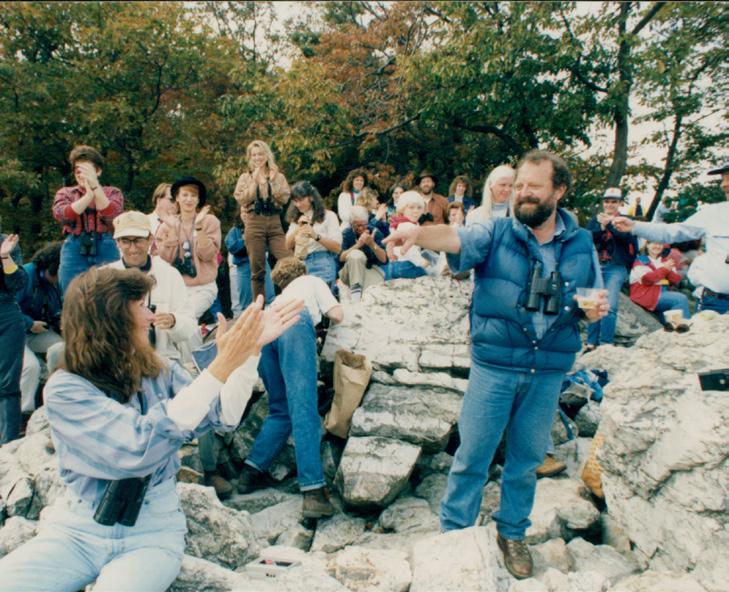
Jim Brett
By Gigi Romano

Hawk Mountain’s Curator Emeritus James Brett passed away late December. He was a Hawk Mountain hero, icon, and friend.
Jim is one of three, and the last person, to hold the position of Curator at Hawk Mountain Sanctuary. Combined with 25 years on the rocks, it’s little surprise so many people forever link his name to their Mountain experience. Here he developed the education program, established the “new” Visitor Center, and founded the international intern program. During his tenure he turned the Sanctuary from a small regional wildlife reserve to an organization of international significance and stature.
A life-long naturalist, he led a 50-year conservation career, driven by his innate ability to build team spirit and camaraderie, and during his retirement, remained connected to Hawk Mountain in myriad ways.
With Keith Bildstein, he co-wrote “Hawk Mountain: A Conservation Success Story,” led history talks at Schaumboch’s Tavern, assisted the staff in connecting them with donors and new volunteers, and always made the effort to meet each trainee class.
“Jim believed deeply in the Sanctuary mission and relayed to every group of interns that each person at the lookout is a conservation opportunity. He urged them to engage with visitors, and share the wonder of the raptors,” recalls Director of Conservation Science Dr. Laurie Goodrich. That style of direct engagement, informal interpretation, and sharing a sincere passion for nature continues to guide the Sanctuary today.
Any experience with Jim brought closeness to wildlife and people. “He loved the rural people everywhere and would stop whether in Mexico, Africa, or Pennsylvania to talk to people along the way, winning hearts,” Goodrich remembers.
A life-long naturalist, Jim was also a prolific writer, and besides other books, many members still recall his beloved column “The Mountain Year,” published annually in the Hawk Mountain News featuring selections from his personal journal of the people and the wildlife that marked each season.
Jim’s many conservation accolades are well documented, but here at Hawk Mountain, he is best known for his generosity of time and friendship…as the man who was a best friend to all and who made each person feel special and valued. He was perhaps the greatest Mountain Friend.
We rely on volunteers to assist in the day-to-day happenings of the Sanctuary and would love to find a space for you on our team. If interested, contact Tammy Jandrasitz at jandrasitz@hawkmountain.org.
40 SPRING 2024 • HAWKMOUNTAIN.ORG
MOUNTAIN FRIEND

TALE WIND
Striped Hairstreak Butterfly, by Bill Moses


www.hawkmountain.org 610.756.6961 Hawk Mountain Sanctuary Association Visitor Center & Administrative Office 1700 Hawk Mountain Road Kempton, PA 19529 Non-profit Organization U.S. Postage PAID Lehigh Valley, PA Permit No. 129 90 YEARS OF HAWK MOUNTAIN SANCTUARY






 Sean Grace PRESIDENT
Sean Grace PRESIDENT














 Illustration by Rebekah Smith
Illustration by Rebekah Smith





















































